Privacy preference center
We care about your privacy
When you visit our website, we will use cookies to make sure you enjoy your stay. We respect your privacy and we’ll never share your resumes and cover letters with recruiters or job sites. On the other hand, we’re using several third party tools to help us run our website with all its functionality.
But what exactly are cookies? Cookies are small bits of information which get stored on your computer. This information usually isn’t enough to directly identify you, but it allows us to deliver a page tailored to your particular needs and preferences.
Because we really care about your right to privacy, we give you a lot of control over which cookies we use in your sessions. Click on the different category headings on the left to find out more, and change our default settings.
However, remember that blocking some types of cookies may impact your experience of our website. Finally, note that we’ll need to use a cookie to remember your cookie preferences.
Without these cookies our website wouldn’t function and they cannot be switched off. We need them to provide services that you’ve asked for.
Want an example? We use these cookies when you sign in to Kickresume. We also use them to remember things you’ve already done, like text you’ve entered into a registration form so it’ll be there when you go back to the page in the same session.
Thanks to these cookies, we can count visits and traffic sources to our pages. This allows us to measure and improve the performance of our website and provide you with content you’ll find interesting.
Performance cookies let us see which pages are the most and least popular, and how you and other visitors move around the site.
All information these cookies collect is aggregated (it’s a statistic) and therefore completely anonymous. If you don’t let us use these cookies, you’ll leave us in the dark a bit, as we won’t be able to give you the content you may like.
We use these cookies to uniquely identify your browser and internet device. Thanks to them, we and our partners can build a profile of your interests, and target you with discounts to our service and specialized content.
On the other hand, these cookies allow some companies target you with advertising on other sites. This is to provide you with advertising that you might find interesting, rather than with a series of irrelevant ads you don’t care about.

University Student Cover Letter Samples & Examples That Worked in 2024

Embarking on the career path, the first step to success is creating a compelling university student cover letter . This powerful tool can unlock doors to internships, jobs, and exciting opportunities within your field of study.
And so, in this guide, we'll equip you with useful tips, real-life examples, and compelling templates, that'll help you get closer to your dream job. Read on and learn about:
- Creating a visually appealing header for your university cover letter
- Researching employers to craft a personalized cover letter
- Writing a compelling introduction as a university student
- Showcasing your best skills and accomplishments as a university student
- Completing your university student cover letter with a strong conclusion
- Finding the best job search resources for university students

1. How to create a visually appealing header for your university cover letter
To begin writing your university student cover letter, your first key step is to create a header.
A cover letter header serves two main purposes: to introduce you to the employer and to give your cover letter an appealing visual structure .
Within your header, you should include:
- Your name and professional title (if you do not have a professional title yet, you can use the title of the job you are applying for and add “Student” at the end)
- Your professional contact information
- The name of the company or organization you are applying to
Here is an example of a well-formatted university student cover letter header
Mason Wilds , Hospitality Management Student (123) 456-7890 | [email protected] | linkedin.com/in/mason-wilds
To: Hilton Head Hotels 1234 Street Address New York, NY
2. How to personalize your university student cover letter
One crucial step to take before beginning to write the body text of your cover letter is to research the employer beforehand. This gives you the opportunity to learn more about them and uncover key details about the company that you can reference throughout your cover letter .
Important information to look for during your research includes:
- Major projects, partnerships, or programs the company is involved in
- The company’s goals, values, and requirements for staff
- The person at the company responsible for hiring and reviewing applications
Using the third piece of information, you can create a personalized greeting that addresses this specific person by name. This lets them know immediately the effort you have put into researching and tailoring your cover letter for them specifically.
Here are 3 examples of personalized cover letter greetings
- Dear Mr. John Applewood,
Dear Hiring Manager John Applewood,
- Dear Mr. John Applewood & the Hiring Department,
3. How to write a compelling introduction as a university student
Next up, you need to begin the body text of your cover letter with a compelling introduction .
To write a strong introduction as a university student, make sure to include:
- A brief overview of your academic experience (most students will have minimal professional experience, making academic experience highly important to describe in a cover letter)
- Your specialized area of expertise (such as the degree you are working toward)
- A concise statement on why you are a great fit for the position
Here is an example of a great introduction from a university student’s cover letter
I am a junior at the University of South Carolina, with two semesters left to complete my degree in Business and Hospitality Management. As I approach my final year of school, I am seeking an internship opportunity with a major hotel chain to hone my hospitality skills and build industry connections. Having earned a spot on my university’s Dean’s List for three consecutive years, I will bring an exceptional work ethic and commitment to excellent service to this position.
Find out your resume score!

4. How to showcase your best skills and accomplishments as a university student
Once your introduction is written and you are satisfied with it, you can move on to writing the remaining body paragraphs of your university student cover letter.
In these body paragraphs, your main goal is to showcase your top skills or accomplishments that are relevant to the job you are applying for. As well as describing these qualifications , you can also use the research you did earlier to reference specific needs of the company and how your skills meet those needs.
Here are 6 examples of skills to describe in a university student cover letter
- Communication (always describe your style of communication)
- Collaboration and teamwork
- Critical thinking
- Time management
- Responsibility
Here is an example of how to describe an accomplishment in a cover letter
As a student at the University of South Carolina, I have served as an Orientation Leader for two years, helping to bring new undergraduate students into the fold and get comfortable in their new surroundings. I recently earned the position of Head Orientation Leader thanks to my overwhelming positive reviews from new students I have mentored. Of the 300+ students I have worked with, 95% gave me a five out of five-star rating at the end of their Orientations.
5. How to complete your university student cover letter with a strong conclusion
The last step to writing your university student cover letter is to craft a strong conclusion . In this conclusion, you should include:
- The best times and days of the week to contact you
- When you are anticipating a response from the employer
- When you plan to follow up with the employer
- A formal sign-off
Here is an example of a strong conclusion from a university student's cover letter
I am honored to be considered for this position and hope to hear from you within the next week regarding this opportunity. You may best reach me at (123) 456-7890 on Mondays through Fridays from 10 a.m. to 7 p.m. As I am excited to learn more about this opportunity, I do plan to follow up next Monday morning if I have not heard back about this position.
Many Thanks,
[Applicant Name]
6. Useful resources for job-seeking university students
As a university student standing at the threshold of a professional career, having the right set of resources can truly empower your job hunt. Let's explore the must-haves in your arsenal:
- University career services: Your own university is a potent resource. Career Services offices often provide resume and cover letter reviews, interview preparation, and job placement assistance. Don't overlook these gems.
- Job search platforms: From LinkedIn to Indeed , these platforms teem with job opportunities perfect for recent graduates. They also offer search filters to streamline the hunt and make it less daunting.
- Field-specific job boards: Niche job boards like Idealist (for non-profits) or Dice (for tech) cater to specific fields, making your job search more focused and productive.
- Online portfolios: Platforms like Behance or GitHub , depending on your field of study, allow you to create an online portfolio showcasing your work. This can be a powerful supplement to your university student cover letter and resume.
- Networking events: Attend career fairs, industry conferences, or university alumni events to build your professional network. You never know which connection might lead to a promising opportunity.
- Internship websites: Websites like Chegg Internships or WayUp specifically cater to students seeking internships, often the stepping stone to a full-time job.
Armed with these resources, you're ready to embark on the exciting and rewarding journey of your job search. Happy hunting!
University Student Cover Letter FAQ
How can i stand out in my university student cover letter, even if i have little to no work experience.
Draw attention to your academic achievements, any relevant coursework, and transferrable skills you’ve developed throughout your academic career. If you have undertaken internships or projects, summarize what you’ve learned from these experiences and how they can bring value to the prospective role.
How long should my university student cover letter be?
Aim to keep it concise and engaging. Typically, a cover letter should not exceed one page. Remember, it's about the quality of your words, not the quantity.
Must I write a new cover letter for each job application?
While it's fine to have a standard outline, your cover letter should always be tailored to each job application. Personalizing your cover letter for each role can show the hiring manager your genuine interest in their specific opportunity.
Should I always include a cover letter even if it's not asked for?
It's generally a good idea to include a cover letter when applying for a job. It gives you another platform to sell your skills and show your enthusiasm for the role and company.
Can I mention extracurricular activities in my cover letter?
Yes, definitely. Extracurricular activities can highlight your team skills, leadership qualities, and dedication. Remember to connect them back to the skills or qualities the job posting is seeking.

Julia Belak
Julia is a Certified Professional Résumé Writer (CPRW™) and an active member of the Professional Association of Résumé Writers & Career Coaches (PARWCC™). She is also a passionate translator and graphic designer. Julia holds degrees in translation and interpretation and has international work experience in various countries across Europe, as well as in China and Panama. Julia formerly taught academic writing and contributed as a graphic designer to outlets such as The Business of Business. You'll often find her with a book in one hand and a specialty coffee in the other, always on the lookout for new insights.
All student cover letter examples
- Formal Sciences Student
- High School Student
- Humanities Student
- Student Internship
- Natural Sciences Student
- Professions And Applied Sciences Student
- Social Sciences Student
All university student cover letter examples

Related university student resume examples

Let your resume do the work.
Join 5,000,000 job seekers worldwide and get hired faster with your best resume yet.


Academic Cover Letters
What is this handout about.
The long list of application materials required for many academic teaching jobs can be daunting. This handout will help you tackle one of the most important components: the cover letter or letter of interest. Here you will learn about writing and revising cover letters for academic teaching jobs in the United States of America.
What is an academic cover letter?
An academic cover letter describes your experiences and interest as a candidate for a specific position. It introduces you to the hiring committee and demonstrates how your academic background fits with the description of the position.
What do cover letters for academic teaching jobs typically contain?
At their most basic level, academic cover letters accomplish three things: one, they express your interest in the job; two, they provide a brief synopsis of your research and teaching; and three, they summarize your past experiences and achievements to illustrate your competence for the job. For early-career scholars, cover letters are typically no more than two pages (up to four pages for senior scholars). Occasionally, a third page may make sense for an early-career scholar if the application does not require a separate teaching statement and/or research statement. Digital versions of cover letters often contain hyperlinks to your CV or portfolio page. For some fields, cover letters may also include examples of your work, including music, popular articles, and other multimedia related to your research, service, or teaching available online. Typically, letters appear on departmental or university letterhead and include your signature. Above all, a strong cover letter presents your accomplishments and your familiarity with the institution and with the position.
How should I prepare to write my academic cover letter?
Like all writing, composing a cover letter is a process. The process may be as short as a few hours or as long as several weeks, but at the end the letter should present you as a strong candidate for the job. The following section has tips and questions for thinking through each stage of this writing process. You don’t need to answer all of these questions to write the letter; they are meant to help you brainstorm ideas.
Before you begin writing your cover letter, consider researching the institution, the department, and the student population. Incorporating all three aspects in your letter will help convey your interest in the position.
Get to know the institution. When crafting your cover letter, be aware of the type of institution to which you are applying. Knowing how the institution presents itself can help you tailor your letter and make it more specific.
- Where is the institution located?
- Is it on a quarter-system or semester-system?
- What type of institution is it? Is it an R1? Is it an R2? Is it a liberal arts college? Is it an HBCU? Is it a community college? A private high school?
- What is the institution’s culture? Is it teaching-focused or research-focused? Does it privilege experiential learning? Does it value faculty involvement outside the classroom? Is it affiliated with a specific religious tradition?
- Does it have any specific institutional commitments?
- How does the institution advocate for involvement in its local community?
- What are the professional development opportunities for new and junior faculty?
Learn about the department. Knowing the specific culture and needs of the department can help you reach your audience: the department members who will be reading your documents and vetting you as a candidate.
- Who is on the search committee? Who is the search committee chair?
- What is the official name of the department?
- Which different subfields make up the department?
- Is it a dual appointment or a position in a dual department?
- How does the department participate in specific types of student outreach?
- Does the department have graduate students? Does it offer a terminal Master’s degree, Ph.D., or both? How large are the cohorts? How are they funded?
- Does the department encourage or engage in interdisciplinary work?
- Does the majority of the department favor certain theoretical or methodological approaches?
- Does the department have partnerships with local institutions? If so, which ones?
- Is the department attempting to fill a specific vacancy, or is it an entirely new position?
- What are the typical course offerings in the department? Which courses might you be expected to teach? What courses might you be able to provide that are not currently available?
Consider the students. The search committee will often consider how you approach instructing and mentoring the student body. Sometimes committees will even reserve a position for a student or solicit student feedback on a candidate:
- What populations constitute the majority of the undergraduate population?
- Have there been any shifts in the student population recently?
- Do students largely come from in-state or out-of-state?
- Is there an international student population? If so, from which countries?
- Is the university recruiting students from traditionally underrepresented populations?
- Are students particularly active on campus? If so, how?
Many answers to these questions can be found both in the job description and on the institution’s website. If possible, consider contacting someone you know at the institution to ask about the culture directly. You can also use the institution’s course catalog, recruitment materials, alumni magazine, and other materials to get answers to these questions. The key is to understand the sort of institution to which you are applying, its immediate needs, and its future trajectory.
Remember, there is a resource that can help you with all three aspects—people. Reach out to your advisor, committee members, faculty mentors, and other contacts for insight into the prospective department’s culture and faculty. They might even help you revise your letter based on their expertise. Think of your job search as an opportunity to cultivate these relationships.
After you have done some initial research, think about how your experiences have prepared you for the job and identify the ones that seem the most relevant. Consider your previous research, internships, graduate teaching, and summer experiences. Here are some topics and questions to get you started thinking about what you might include.
Research Experiences. Consider how your research has prepared you for an academic career. Since the letter is a relatively short document, select examples of your research that really highlight who you are as a scholar, the direction you see your work going, and how your scholarship will contribute to the institution’s research community.
- What are your current research interests?
- What topics would you like to examine in the future?
- How have you pursued those research interests?
- Have you traveled for your research?
- Have you published any of your research? Have you presented it at a conference, symposium, or elsewhere?
- Have you worked or collaborated with scholars at different institutions on projects? If so, what did these collaborations produce?
- Have you made your research accessible to your local community?
- Have you received funding or merit-based fellowships for your research?
- What other research contributions have you made? This may include opinion articles, book chapters, or participating as a journal reviewer.
- How do your research interests relate to those of other faculty in the department or fill a gap?
Teaching Experience. Think about any teaching experience you may have. Perhaps you led recitations as a teaching assistant, taught your own course, or guest lectured. Pick a few experiences to discuss in your letter that demonstrate something about your teaching style or your interest in teaching.
- What courses are you interested in teaching for the department? What courses have you taught that discussed similar topics or themes?
- What new courses can you imagine offering the department that align with their aim and mission?
- Have you used specific strategies that were helpful in your instruction?
- What sort of resources do you typically use in the classroom?
- Do you have anecdotes that demonstrate your teaching style?
- What is your teaching philosophy?
- When have you successfully navigated a difficult concept or topic in the classroom, and what did you learn?
- What other opportunities could you provide to students?
Internships/Summer/Other Experiences. Brainstorm a list of any conferences, colloquiums, and workshops you have attended, as well as any ways you have served your department, university, or local community. This section will highlight how you participate in your university and scholarly community. Here are some examples of things you might discuss:
- Professional development opportunities you may have pursued over the summer or during your studies
- International travel for research or presentations
- Any research you’ve done in a non-academic setting
- Presentations at conferences
- Participation in symposia, reading groups, working groups, etc.
- Internships in which you may have implemented your research or practical skills related to your discipline
- Participation in community engagement projects
- Participation in or leadership of any scholarly and/or university organizations
In answering these questions, create a list of the experiences that you think best reflect you as a scholar and teacher. In choosing which experiences to highlight, consider your audience and what they would find valuable or relevant. Taking the time to really think about your reader will help you present yourself as an applicant well-qualified for the position.
Writing a draft
Remember that the job letter is an opportunity to introduce yourself and your accomplishments and to communicate why you would be a good fit for the position. Typically, search committees will want to know whether you are a capable job candidate, familiar with the institution, and a great future addition to the department’s faculty. As such, be aware of how the letter’s structure and content reflect your preparedness for the position.
The structure of your cover letter should reflect the typical standards for letter writing in the country in which the position is located (the list below reflects the standards for US letter writing). This usually includes a salutation, body, and closing, as well as proper contact information. If you are affiliated with a department, institution, or organization, the letter should be on letterhead.
- Use a simple, readable font in a standard size, such as 10-12pt. Some examples of fonts that may be conventional in your field include Arial, Garamond, Times New Roman, and Verdana, among other similar fonts.
- Do not indent paragraphs.
- Separate all paragraphs by a line and justify them to the left.
- Make sure that any included hyperlinks work.
- Include your signature in the closing.
Before you send in your letter, make sure you proofread and look for formatting mistakes. You’ll read more about proofreading and revising later in this handout!
The second most important aspect of your letter is its content. Since the letter is the first chance to provide an in-depth introduction, it should expand on who you are as a scholar and possible faculty member. Below are some elements to consider including when composing your letter.
Identify the position you are applying to and introduce yourself. Traditionally, the first sentence of a job letter includes the full name of the position and where you discovered the job posting. This is also the place to introduce yourself and describe why you are applying for this position. Since the goal of a job letter is to persuade the search committee to include you on the list of candidates for further review, you may want to include an initial claim as to why you are a strong candidate for the position. Some questions you might consider:
- What is your current status (ABD, assistant professor, post-doc, etc.)?
- If you are ABD, have you defended your dissertation? If not, when will you defend?
- Why are you interested in this position?
- Why are you a strong candidate for this position?
Describe your research experience and interests. For research-centered positions, such as positions at R1 or other types of research-centered universities, include information about your research experience and current work early in the letter. For many applicants, current work will be the dissertation project. If this is the case, some suggest calling your “dissertation research” your “current project” or “work,” as this may help you present yourself as an emerging scholar rather than a graduate student. Some questions about your research that you might consider:
- What research experiences have you had?
- What does your current project investigate?
- What are some of the important methods you applied?
- Have you collaborated with others in your research?
- Have you acquired specific skills that will be useful for the future?
- Have you received special funding? If so, what kind?
- Has your research received any accolades or rewards?
- What does your current project contribute to the field?
- Where have you presented your research?
- Have you published your research? If so, where? Or are you working on publishing your work?
- How does your current project fit the job description?
Present your plans for future research. This section presents your research agenda and usually includes a description of your plans for future projects and research publications. Detailing your future research demonstrates to the search committee that you’ve thought about a research trajectory and can work independently. If you are applying to a teaching-intensive position, you may want to minimize this section and/or consider including a sentence or two on how this research connects to undergraduate and/or graduate research opportunities. Some questions to get you started:
- What is your next research project/s?
- How does this connect to your current and past work?
- What major theories/methods will you use?
- How will this project contribute to the field?
- Where do you see your specialty area or subfield going in the next ten years and how does your research contribute to or reflect this?
- Will you be collaborating with anyone? If so, with whom?
- How will this future project encourage academic discourse?
- Do you already have funding? If so, from whom? If not, what plans do you have for obtaining funding?
- How does your future research expand upon the department’s strengths while simultaneously diversifying the university’s research portfolio? (For example, does your future research involve emerging research fields, state-of-the-art technologies, or novel applications?)
Describe your teaching experience and highlight teaching strategies. This section allows you to describe your teaching philosophy and how you apply this philosophy in your classroom. Start by briefly addressing your teaching goals and values. Here, you can provide specific examples of your teaching methods by describing activities and projects you assign students. Try to link your teaching and research together. For example, if you research the rise of feminism in the 19th century, consider how you bring either the methodology or the content of your research into the classroom. For a teaching-centered institution, such as a small liberal arts college or community college, you may want to emphasize your teaching more than your research. If you do not have any teaching experience, you could describe a training, mentoring, or coaching situation that was similar to teaching and how you would apply what you learned in a classroom.
- What is your teaching philosophy? How is your philosophy a good fit for the department in which you are applying to work?
- What sort of teaching strategies do you use in the classroom?
- What is your teaching style? Do you lecture? Do you emphasize discussion? Do you use specific forms of interactive learning?
- What courses have you taught?
- What departmental courses are you prepared to teach?
- Will you be able to fill in any gaps in the departmental course offerings?
- What important teaching and/or mentoring experiences have you had?
- How would you describe yourself in the classroom?
- What type of feedback have you gotten from students?
- Have you received any awards or recognition for your teaching?
Talk about your service work. Service is often an important component of an academic job description. This can include things like serving on committees or funding panels, providing reviews, and doing community outreach. The cover letter gives you an opportunity to explain how you have involved yourself in university life outside the classroom. For instance, you could include descriptions of volunteer work, participation in initiatives, or your role in professional organizations. This section should demonstrate ways in which you have served your department, university, and/or scholarly community. Here are some additional examples you could discuss:
- Participating in graduate student or junior faculty governance
- Sitting on committees, departmental or university-wide
- Partnerships with other university offices or departments
- Participating in community-partnerships
- Participating in public scholarship initiatives
- Founding or participating in any university initiatives or programs
- Creating extra-curricular resources or presentations
Present yourself as a future faculty member. This section demonstrates who you will be as a colleague. It gives you the opportunity to explain how you will collaborate with faculty members with similar interests; take part in departmental and/or institution wide initiatives or centers; and participate in departmental service. This shows your familiarity with the role of faculty outside the classroom and your ability to add to the departmental and/or institutional strengths or fill in any gaps.
- What excites you about this job?
- What faculty would you like to collaborate with and why? (This answer may be slightly tricky. See the section on name dropping below.)
- Are there any partnerships in the university or outside of it that you wish to participate in?
- Are there any centers associated with the university or in the community that you want to be involved in?
- Are there faculty initiatives that you are passionate about?
- Do you have experience collaborating across various departments or within your own department?
- In what areas will you be able to contribute?
- Why would you make an excellent addition to the faculty at this institution?
Compose a strong closing. This short section should acknowledge that you have sent in all other application documents and include a brief thank you for the reader’s time and/or consideration. It should also state your willingness to forward additional materials and indicate what you would like to see as next steps (e.g., a statement that you look forward to speaking with the search committee). End with a professional closing such as “Sincerely” or “Kind Regards” followed by your full name.
If you are finding it difficult to write the different sections of your cover letter, consider composing the other academic job application documents (the research statement, teaching philosophy, and diversity statement) first and then summarizing them in your job letter.
Different kinds of letters may be required for different types of jobs. For example, some jobs may focus on research. In this case, emphasize your research experiences and current project/s. Other jobs may be more focused on teaching. In this case, highlight your teaching background and skills. Below are two models for how you could change your letter’s organization based on the job description and the institution. The models offer a guide for you to consider how changing the order of information and the amount of space dedicated to a particular topic changes the emphasis of the letter.
Research-Based Position Job Letter Example:
| Date: Month Day, Year Search Committee Chair’s First and Last Name, Graduate Degree Dear Dr./Mr./Ms. Search Committee Chair’s last name and/or Search Committee Members: Paragraph 1 [3-5 Sentences]: Identify the position you are applying for. Introduce yourself to the committee and your research interests. Connect your interests to the department and describe what makes you interested in becoming part of this departmental community. Paragraph 2 [3-5 Sentences]: Briefly explain your research to date. Consider mentioning your research questions, methods, key findings, as well as where and when you published and/or presented this work. Paragraph 3 [4-5 Sentences]: Elaborate on your current research project. Consider mentioning your most prestigious funding awards for this project. Explain your key findings in more detail. Paragraph 4 [3-5 Sentences]: Introduce your future research plans and goals. Point out the intellectual merit and/or broader impacts of this future work. Paragraph 5 [3-5 Sentences]: Briefly discuss your teaching experience and strategies. Provide examples of teaching strategies or an anecdote highlighting your teaching effectiveness. You may also want to introduce your philosophy on diversity in an academic setting. Paragraph 6 [2-3 Sentences]: Make a connection between your work and the department to which you are applying. Include how you will participate in the intellectual life of the department both inside and outside the classroom. Provide concrete examples of how you will be a hard-working and collaborative colleague. Paragraph 7 [1-2 Sentences]: A thank you for the search committee’s time and consideration. Sincerely, Your Name |
Teaching-Based Position Job Letter Example:
| Date: Month Day, Year Search Committee Chair’s First and Last Name, Graduate Degree Dear Dr./Mr./Ms. Search Committee Chair’s last name and/or Search Committee Members: Paragraph 1 [3-5 Sentences]: Identify the position you are applying for. Introduce yourself to the committee and your research interests. Connect your interests to the department and describe what makes you interested in becoming part of this departmental community. Paragraph 2 [3-5 Sentences]: Briefly discuss your teaching experience and pedagogical commitments. Provide examples of teaching strategies or an anecdote highlighting your teaching effectiveness. You may also want to introduce your philosophy on diversity in an academic setting. Paragraph 3 [3-4 Sentences]: Provide a discussion of how you involved yourself with students or the broader university community outside of the traditional classroom setting. Discuss how those interactions influenced your teaching. Paragraph 4 [2-3 Sentences]: Briefly explain your current research interests to date and how it relates to your teaching. State your research questions, methods, and key findings or arguments. Point out the intellectual merit and/or broader impacts of this future work. Paragraph 5 [3-5 Sentences]: Highlight when and where your research was published and/or presented this work or any forthcoming publications. Mention any prestigious funding or awards. Introduce your future research plans and goals. Paragraph 6 [2-3 Sentences]: Make a connection between your work and the department to which you are applying. Include how you will participate in the intellectual life of the department both inside and outside the classroom. Provide concrete examples of how you will be a hard-working and collaborative colleague. Paragraph 7 [1-2 Sentences]: A thank you for the search committee’s time and consideration. Sincerely, Your Name |
Remember your first draft does not have to be your last. Try to get feedback from different readers, especially if it is one of your first applications. It is not uncommon to go through several stages of revisions. Check out the Writing Center’s handout on editing and proofreading and video on proofreading to help with this last stage of writing.
Potential pitfalls
Using the word dissertation. Some search committee members may see the word “dissertation” as a red flag that an applicant is too focused on their role as a graduate student rather than as a prospective faculty member. It may be advantageous, then, to describe your dissertation as current research, a current research project, current work, or some other phrase that demonstrates you are aware that your dissertation is the beginning of a larger scholarly career.
Too much jargon. While you may be writing to a specific department, people on the search committee might be unfamiliar with the details of your subfield. In fact, many committees have at least one member from outside their department. Use terminology that can easily be understood by non-experts. If you want to use a specific term that is crucial to your research, then you should define it. Aim for clarity for your reader, which may mean simplification in lieu of complete precision.
Overselling yourself. While your job letter should sell you as a great candidate, saying so (e.g., “I’m the ideal candidate”) in your letter may come off to some search committee members as presumptuous. Remember that although you have an idea about the type of colleague a department is searching for, ultimately you do not know exactly what they want. Try to avoid phrases or sentences where you state you are the ideal or the only candidate right for the position.
Paying too much attention to the job description. Job descriptions are the result of a lot of debate and compromise. If you have skills or research interests outside the job description, consider including them in your letter. It may be that your extra research interests; your outside skills; and/or your extracurricular involvements make you an attractive candidate. For example, if you are a Latin Americanist who also happens to be well-versed in the Spanish Revolution, it could be worth mentioning the expanse of your research interests because a department might find you could fill in other gaps in the curriculum or add an additional or complementary perspective to the department.
Improper sendoff. The closing of your letter is just as important as the beginning. The end of the letter should reflect the professionalism of the document. There should be a thank-you and the word sincerely or a formal equivalent. Remember, it is the very last place in your letter where you present yourself as a capable future colleague.
Small oversights. Make sure to proofread your letter not just for grammar but also for content. For example, if you use material from another letter, make sure you do not include the names of another school, department, or unassociated faculty! Or, if the school is in Chicago, make sure you do not accidentally reference it as located in the Twin Cities.
Name dropping. You rarely know the internal politics of the department or institution to which you are applying. So be cautious about the names you insert in your cover letters. You do not want to unintentionally insert yourself into a departmental squabble or add fire to an interdepartmental conflict. Instead, focus on the actions you will undertake and the initiatives you are passionate about.
Works consulted
We consulted these works while writing this handout. This is not a comprehensive list of resources on the handout’s topic, and we encourage you to do your own research to find additional publications. Please do not use this list as a model for the format of your own reference list, as it may not match the citation style you are using. For guidance on formatting citations, please see the UNC Libraries citation tutorial . We revise these tips periodically and welcome feedback.
Ball, Cheryl E. 2013. “Understanding Cover Letters.” Inside Higher Ed , November 3, 2013. https://www.insidehighered.com/advice/2013/11/04/essay-cover-letter-academic-jobs .
Borchardt, John. 2014. “Writing a Winning Cover Letter.” Science Magazine , August 6, 2014. https://www.sciencemag.org/careers/2014/08/writing-winning-cover-letter# .
Helmreich, William. 2013. “Your First Academic Job.” Inside Higher Ed , June 17, 2013. https://www.insidehighered.com/advice/2013/06/17/essay-how-land-first-academic-job .
Kelsky, Karen. 2013. “How To Write a Journal Article Submission Cover Letter.” The Professor Is In (blog), April 26, 2013. https://theprofessorisin.com/2013/04/26/how-to-write-a-journal-article-submission-cover-letter/ .
Tomaska, Lubomir, and Josef Nosek. 2008. “Ten Simple Rules for Writing a Cover Letter to Accompany a Job Application for an Academic Position.” PLoS Computational Biology 14(5). https://doi.org/10.1371/journal.pcbi.1006132 .
You may reproduce it for non-commercial use if you use the entire handout and attribute the source: The Writing Center, University of North Carolina at Chapel Hill
Make a Gift

- Appointments

- Resume Reviews

- Undergraduates
- PhDs & Postdocs
- Faculty & Staff
- Prospective Students
- Online Students
- Career Champions
- I’m Exploring
- Architecture & Design
- Education & Academia
- Engineering
- Fashion, Retail & Consumer Products
- Fellowships & Gap Year
- Fine Arts, Performing Arts, & Music
- Government, Law & Public Policy
- Healthcare & Public Health
- International Relations & NGOs
- Life & Physical Sciences
- Marketing, Advertising & Public Relations
- Media, Journalism & Entertainment
- Non-Profits
- Pre-Health, Pre-Law and Pre-Grad
- Real Estate, Accounting, & Insurance
- Social Work & Human Services
- Sports & Hospitality
- Startups, Entrepreneurship & Freelancing
- Sustainability, Energy & Conservation
- Technology, Data & Analytics
- DACA and Undocumented Students
- First Generation and Low Income Students
- International Students
- LGBTQ+ Students
- Transfer Students
- Students of Color
- Students with Disabilities
- Explore Careers & Industries
- Make Connections & Network
- Search for a Job or Internship
- Write a Resume/CV
- Write a Cover Letter
- Engage with Employers
- Research Salaries & Negotiate Offers
- Find Funding
- Develop Professional and Leadership Skills
- Apply to Graduate School
- Apply to Health Professions School
- Apply to Law School
- Self-Assessment
- Experiences
- Post-Graduate
- Jobs & Internships
- Career Fairs
- For Employers
- Meet the Team
- Peer Career Advisors
- Career Services Policies
- Walk-Ins & Pop-Ins
- Strategic Plan 2022-2025
Cover Letter Writing Guide
The purpose of a cover letter.

Anatomy of a Cover Letter
Sometimes called a “letter of intent” or “letter of interest”, a cover letter is an introduction to the rest of your job application materials (e.g., resume/CV, research statement, teaching philosophy, writing samples, etc.). The purpose of a cover letter is to quickly summarize why you are applying to an organization or for a particular position, and what skills and knowledge you bring that make you the most suitable candidate for that position. The cover letter is often the first impression that a prospective employer will have of you, especially if they do not know you, or have not heard about you from their network of contacts. First impressions count, and so getting your cover letter right is a critical step in your job application process. Like all your job application materials, it may take time and focus to write your cover letters well. You will likely have several drafts before you come up with a final version that clearly articulates your skills and your understanding of the employer and the job requirements.
While your resume briefly states your skills, knowledge, experience, and (most importantly) what you have achieved using your abilities, the cover letter gives you an opportunity to create a narrative that shows the path you have taken in your career or education, emphasizing the skills you’ve used along the way, and explaining why the position you are applying to is the next desirable step on this path. To find out more about the structure of the cover letter, you can see some examples here. Also, it is important to know that there are some differences between cover letters written for faculty positions and those written for non-faculty positions. You can review some of the key differences of cover letters for faculty positions here .
When you start the process of looking for job opportunities, you will probably read through lots of job advertisements. You will notice that most job ads ask for a cover letter of some sort. The exception to this might be when you apply for some jobs through an employer’s online job application system, where they may ask you to upload your letter as a document, cut and paste the contents of your letter into specific fields, or they may not ask for a letter at all. For most jobs, and whenever you are submitting a formal application, cover letters are usually expected – and can be very helpful – even if a letter is not requested in the job ad itself.
Cover Letter Etiquette
You might be tempted to send the same version of your cover letter to multiple employers, especially if you are applying for similar types of positions. Don’t. It can be fairly obvious to an employer when they receive a stock letter, and this will make a bad first impression. Tailor your letter to the employer and to the specific job. This may require you to do some background research on the employer’s website, or talk to someone you know (or don’t yet know) who already works there. Use this information to explain why you want to work at that particular place, doing that particular job. It takes time, but it is worth it. You’ll probably have more luck with three tailored cover letters than with 30 stock letters sent out to 30 different employers. Your cover letter will be read by someone as part of a formal job application, so make certain that it is free of spelling mistakes, grammar issues, and typos. Make sure your cover letter fits onto 1 page (for non-academic position applications), has consistent margins and formatting, and a readable font that is between 10-12pts.
When Not to Use Cover Letters: There are some occasions during the job search process where cover letters shouldn’t be used. During career fairs, you would typically only hand out your resume to employers (and a 1-page resume is ideal). Employers want to be able to quickly scan your resume for the key points, and you should be able to verbally communicate some of the ideas that a letter might contain (for example, why this company interests you). Recruiters won’t have the time to read a letter.
Timeline: Getting Started with your Cover Letter
Step 1: The first step to writing a good cover letter is to first have a good resume. For information on putting these documents together, click here . Your cover letter expands upon some of the information you include within these documents, and describes the role you have played in achieving your academic or non-academic goals (i.e., showing how your experiences have made you the best candidate for the position).
Step 2: The next step is to find an open position that interests you, or at least the type of job to which you want to apply. There is no such thing as a one-size-fits-all cover letter, as each should be tailored to each job you apply to, but there will certainly be parts of the letter that will stay much the same, and be appropriate for multiple jobs. This might mean changing some of the key words in the letter, so that you are describing your experience in the employer’s language (using some of their keywords), not your own.
Step 3: Go through the job ad and carefully note all of the requirements and skills the employer is looking for. Based on your background research of the employer and the people you have spoken to who know about this employer, try to identify the two or three most important skills that the employer is looking for. You should then try to create a cover letter that illustrates that you have these skills and have used them effectively. Your cover letter will be stronger if it addresses these requirements and the job duties. Ensure that you talk about your experiences in the language used by the employer, echoing their words in descriptions you use to illustrate your skills. Write out a list of the keywords that you highlighted from the job ad, and then next to each of these words, write a brief statement that illustrates the fact that you have this skill/ability/knowledge using a specific example. You may not have an experience for all of the requirements, but the more you think about what you have achieved, the more likely it is that you will find something relevant to talk about. When you have all of this information, then you can begin to structure it within the format of a formal cover letter.
Cover letter template
Here is a general template for a cover letter:
Your Name Street Address City, State, Zip Email and phone number
Today’s Date
Mr./Ms./Dr. Name Title Organization
Dear ______:
The opening paragraph should explain why you are writing, giving your specific employment interest. Mention how you found out about the position. If it was advertised, refer to the website or resource in which you saw it. If a contact told you about it, say so. It is also helpful to include an overall summary of the key skills, knowledge areas, or experiences that you are bring to this role right here in the first paragraph. If you start off with these very specific conclusions that confidently state that you have what the employer is looking for, then the reader will also have a lot of confidence that your letter and resume are worth reading. The next paragraphs will then expand on and illustrate what you are summarizing in this first paragraph.
The middle paragraph(s) should summarize the aspects of your background which will interest the employer. The more information you have about the organization and its needs, the better. Discuss your qualifications in terms of the contributions you can make. While you should not repeat your resume verbatim, don’t hesitate to refer to the most important information discussed in it. Ideally, both your cover letter and your CV/resume would be able to stand alone. It is not necessary to describe yourself in superlatives. Rather than saying, “I can make a uniquely valuable contribution to your organization,” give the employer enough relevant, targeted information to allow the reader to reach that conclusion independently. Be specific and credible. Tell stories that have a touch of drama, for example: “When I was working as the president of X student group, one of the challenges that we faced was XYZ.” Once you have created a touch of drama, describe how you used your skills to overcome it, for example: “So what I had to do was build relationships with administrators on campus by communicating the critical role our group played in doing ABC.” Once you have told the story, reflect on it in terms of how this is particularly relevant for the reader, for example: “I really enjoyed being placed in a position where I had to reach out to contact and bring them all together by creating a shared vision for everyone to buy into. I think this combination of strong marketing skills and relationship building will be valuable to the role of Advertising Associate.”
The closing paragraph should explain why the position and the particular organization is attractive to you, and should hopefully pave the way for the interview. Provide an authentic reason why you are excited about bringing your skills to the role, and what you will also gain from being in the role. Speaking with former or current employees at the organization as part of your networking will help in this regards. You can also offer to send any additional information, restate your contact details, and state that you look forward to hearing from them.
Writing Cover Letters for University Applications [2023 Guide]
Applying to university can be a daunting experience, especially when it comes to crafting the perfect cover letter for your application. A well-written cover letter can be the deciding factor between getting accepted into your dream program or receiving a rejection letter. In this guide, we will explore the importance of a strong cover letter, its purpose, format, content, and provide tips and examples to help you craft a compelling cover letter for your university application.
A cover letter for a university application is an essential document that can make or break your chances of getting admitted to your dream program. The importance of a strong cover letter in the application process cannot be understated, as it serves to introduce you, showcase your achievements, and demonstrate your passion for the chosen program or course.
In this article, we will cover:
- The purpose of a cover letter for university applications
- The format and structure of a cover letter
- The content and elements of an effective cover letter
- Tips for writing a compelling cover letter
- Common cover letter mistakes to avoid
- Sample cover letters for university applications
By following the advice and guidance provided in this article, you will be well-equipped to create a cover letter that stands out from the competition and increases your chances of admission. So, let's dive in and learn how to craft the perfect cover letter for your university application!
Purpose of a Cover Letter for University Applications
The primary purpose of a cover letter is to introduce the applicant, showcase their achievements, and demonstrate their passion for the chosen program or course. A cover letter complements other application materials, such as your resume and transcripts, by highlighting your unique qualities and strengths that may not be evident in those documents.
An effective cover letter can also demonstrate your motivation and commitment to the program, which can influence the admissions committee's decision. For example, MIT's Career Advising & Professional Development office explains that a well-crafted cover letter can help set you apart from other applicants by providing context and a personal touch to your application.
Format and Structure of a Cover Letter
A proper format and structure are crucial for creating a professional and effective cover letter for a university application. A standard cover letter typically includes:
- Header (with your contact information and the date)
- Salutation (addressing the recipient)
- Introduction (capturing the reader's attention)
- Body (highlighting your qualifications, achievements, and passion)
- Conclusion (leaving a lasting impression)
- Complimentary close (e.g., "Sincerely," followed by your name)
Proper formatting, such as using an appropriate font, font size, and margin settings, is essential for creating a polished and professional appearance. Keep your language clear and concise, and make sure to proofread and edit your letter to ensure it is error-free.
Content and Elements of a Cover Letter
A successful cover letter for a university application should contain specific elements that demonstrate the applicant's qualifications, achievements, and passion for the program. These elements include:
- Addressing the letter to the appropriate recipient
- Crafting an engaging introduction that captures the reader's attention
- Including essential elements in the body of the letter, such as academic interests, extracurricular activities, and relevant experiences
- Writing a compelling conclusion that leaves a lasting impression
Tailoring the content to the specific university or program is crucial, as demonstrated by Seattle Pacific University's Career Services . They advise that telling stories about your skills and experiences that are relevant to the specific program can help make your cover letter more effective.
Tips for Writing an Effective Cover Letter
Following certain tips and best practices can significantly improve the quality and impact of a cover letter for a university application:
- Research the university and program before writing the letter to better understand their values and expectations.
- Showcase your unique qualities and strengths by providing specific examples and details.
- Use strong action verbs and avoid clichés or overused phrases, as suggested by Freesumes .
- Seek feedback from teachers, counselors, or peers to ensure your cover letter is polished and compelling.
- Revise and refine your letter until it accurately represents your passion and qualifications for the program.
Common Cover Letter Mistakes to Avoid
Avoiding common cover letter mistakes is essential for creating a strong and effective university application:
- Address the letter to the correct recipient to show your attention to detail and professionalism.
- Avoid using generic or overly broad language, which can make your letter less impactful.
- Submit a well-formatted and professional-looking letter to convey your seriousness and commitment.
- Refrain from including irrelevant or excessive information that distracts from your main strengths.
- Proofread and edit your letter to eliminate typos, grammatical errors, and other mistakes that can undermine its impact.
Sample Cover Letters for University Applications
Examining sample cover letters can provide valuable insights and inspiration for crafting a successful university application. We recommend:
- Analyzing high-quality sample cover letters for various university programs or courses
- Identifying the strengths and weaknesses of each sample
- Adapting the samples to your specific situation and application
- Using the samples as a starting point for creating your unique cover letter
- Remembering to tailor your letter to the specific university or program
With proper research, planning, and execution, a well-crafted cover letter can significantly enhance a university application and increase the chances of admission. By applying the tips and guidance provided in this article, you will be well-prepared to create a compelling cover letter that showcases your passion, achievements, and qualifications for your dream program.
As a final piece of advice, remember that persistence and dedication are key to success in the university application process. Keep refining your cover letter and learning from feedback until you have a polished and impactful document that truly represents you. Good luck on your university application journey!
Skip navigation

- Summer Updates
- For Employers
- In the Know
- Make An Appointment
- Internships
- Employer Connections
- CCE Programs
- Funding Programs
- Drop-in Hours
- Career Counseling Appointments
- Practice Interviews
- Programs & Services
- Design Your Next Steps
- Resumes & CVs
- Cover Letters
- Negotiating
- Career Advancement
- Graduate School
- Premium Resources
- Communications & Media
- Engineering & Technology
- Environment & Sustainability
- Financial Services
- International Affairs
- Non-Profits & Social Justice
- Psychology, Counseling, & Social Work
- Ways to Gain Experience
- Career Assessments
- Connect With Alumni
- Student Experiences
- First-Generation/Low-Income Students
- International Students
- Students with Disabilities
- Veteran Students
- LGBTQ Students
- Visiting Students
- Students of Color
Sample Cover Letters
Look through these sample cover letters to get an idea of what to include in your letter. Do not copy them directly!
The most important quality you can convey in your cover letter is enthusiasm, and this must be done in your own style.
Read our tips for writing a great cover letter . We suggest that you write the first draft of your letter without using a sample to guide you. Once you’ve created your first letter, those that follow will be much easier.
Undergraduate Internship
Layla D’Antonio New York, NY | [email protected] | (212) 555-0000
February 5, 2023
Dear Ms. Chan,
I am writing to express my interest in CNN’s editorial internship as part of the Columbia Experience Overseas Hong Kong. With a keen interest in media production and journalism, I am eager to explore these fields in one of the world’s fastest-growing markets. As a rising sophomore at Columbia University studying psychology with a concentration in sustainable development, I am excited to apply my cultural awareness and critical thinking skills, as well as my creativity and teamwork skills to this position.
For the past year, I have worked with the Columbia Video Network to record classes for the developing online sector of Columbia University School of Engineering. My colleagues and I produced content that students around the world can access for their online programs. Additionally, I played a vital role managing our social media presence via Facebook and Twitter, increasing the network’s online exposure by sharing photos from our production room, writing posts about advancements in technology, and sharing engineering-related content. Through this experience, I familiarized myself with media outlets and increased engagement with prospective students.
Currently, as Division I student-athlete, I continuously develop my perseverance, mental stamina and time management skills. I have learned to master the art of balancing a demanding schedule while navigating a fast-paced environment. My experience as an athlete has also helped me to become an effective leader and communicator, acting as a liaison between my teammates and coaching staff. All are skills I expect to use at CNN.
I am excited by the opportunity to contribute to one of the world’s leading news organizations while exploring my curiosity in the use of technology as a tool to transmit knowledge through visual media. I look forward to the opportunity to learn how CNN integrates these tools within the news landscape, and to grow as a journalist and creative thinker. Thank you for your consideration.
Sincerely, Layla D’Antonio
Creative Industry
Sara Danson New York, NY • +1 (202) 555-0188 • [email protected]
April 26, 2023
Dear Hiring Team,
Growing up with a political historian as my father, I learned a crucial lesson: to care about people, you have to care about politics. In this vein, I have long admired the Center for Democratic Progress, using your reports and articles to help define my own policy positions. As I prepare to graduate from Columbia University with a degree in American studies and creative writing in May, I want to work for an organization that lets me act on my care for people every day. With seven years of editorial experience, I think I could do great work as Democratic Progress’ Assistant Editor.
I first honed my editing skills as a journalist. Working for Elementary, I wrote and copy edited dozens of articles using AP Style – everything from long-form investigations of standardized testing to columns about Common Core. I posted and formatted articles and photos on Elementary’s WordPress site, and managed production of the magazine’s quarterly print issues. For this work, I wrote headlines, blurbs, and photo captions as needed, and used Adobe Photoshop and InDesign regularly. I have done similar work as a writer for the Daily Noise, a workshop participant at Columbia, and the sole editor of The Soul in Our Soles, a full-length book. Through these experiences, I have edited hundreds of pages, adjusted to new style guides and expectations, and learned how to give my feedback clearly and diplomatically. So, too, have I honed my attention to detail and accuracy, learned how to work independently and under time pressure, and kept track of small-moving parts across several projects at once.
In other jobs, I have channeled my political views into meaningful work. As an intern for the League Against Hate Speech and Detroit for All, a nonprofit which helps immigrants and refugees in Southeast Michigan, I worked with teams to advocate progressive policy positions by planning trips, conferences, and community-wide events. As part of this work, I communicated with a wide range of individuals – wealthy businessmen, Bhutanese refugees, and Israeli activists alike – and sharpened my written and verbal communications skills. I also gave my colleagues operational support, copying and filing papers, scheduling meetings, and inputting data into Salesforce, among other tasks. These experiences taught me when to ask for help, how to solve problems, and how to organize my work and others’ well. At the same time, I learned firsthand how satisfying it is to work hard for a cause you believe in.
Given the opportunity, I would love to do that work for Democratic Progress as your Assistant Editor. I would be able to relocate to Washington, D.C. quickly upon hiring. Thank you so much for your time and consideration, and I look forward to hearing from you.
Sincerely, Sara Danson
Engineering
Devon Fisher 917-555-0000 | [email protected] | New York, NY
March 11, 2023
Vince Winchester Thornton Tomasetti 51 Madison Ave #19 New York, NY 10010
Dear Mr. Winchester,
I am writing to express my interest in the Energy Analyst internship at Thornton Tomasetti. After connecting with Recruitment manager Charlotte Greene at Columbia University’s Sustainability Career Fair, and learning about the company’s impact in the sustainable engineering space, I knew I needed to apply. I am a senior at Columbia majoring in Mechanical Engineering and believe that my critical thinking and interpersonal skills along with my commitment to engaging in complex engineering problems would be an asset to your team.
During my internship with ERS, I successfully employed my critical thinking skills and interpersonal skills to pinpoint cost-effective retrofit measures on a very limited budget and with little manpower. While working on heat load models, I realized that improving the insulation of a building could result in greater savings than the team’s HVAC focus. With approval from my boss, I was able to take initiative to create a new framework for implementing insulation and envelope repairs. Using this idea, the team discovered that one of the school sites could save over $30,000 a year on electricity through insulation upgrades.
Currently, I am leading a project for the Columbia Formula SAE team researching and analyzing sensors with a goal to wire a car to increase speed and validate load predictions. This project is particularly relevant to the current trends in the energy efficiency space, as sensors exist in buildings and retrofit projects need to be validated. My current coursework complements my experience in its focus on statistical programming for modeling environmental issues. For example, I am working on a project using machine learning to predict roofs in New York City that need insulation.
I am excited by the opportunity to be on a team that collaborates to help clients meet their engineering and sustainability goals, and where I can showcase my mechanical engineering skills. Thank you for considering me to join the Thornton Tomasetti team.
Sincerely, Devon Fisher
Experienced
AMY M. ROBINS 212-555-1212 • [email protected]
August 22, 2022
Dear Ms. Kramer,
I am writing to apply to your grant writer position. When I saw this posting on your website, I was immediately drawn to AIDG’s focus on business incubation and eco-friendly technologies, and believe your model offers many opportunities to create lasting improvements to infrastructures in Guatemala and Haiti. To help your company gain further funding for its mission, I offer proven writing, research, and communication skills as well as successful grant writing experience.
I was inspired to transition from magazine writing to grant writing when I started editing documents for the Refugee and Immigrant Fund (RIF), a not-for-profit agency that aids new immigrants as they adjust to life in the United States. Working with RIF’s founder to create two grant applications, I found my editorial background equipped me well for the challenges of drafting and editing proposals to secure not-for-profit funding. Both applications were successful and resulted in grants needed to support two new programs.
Additionally, as the Assistant Research Editor at Budget Travel magazine, I pinpoint the most engaging details of a subject and write stories that appeal to a targeted audience. These skills have helped me create grant applications that draw attention from an audience of grant givers and personal donors.
Finally, every day at Budget Travel, I communicate effectively across language barriers. Maintaining my record of zero printed errors, I routinely call and email small foreign businesses, from family-owned restaurants in Panama to three-room B&Bs in Italy. My French language proficiency, further refined when I studied in Senegal, will help me work closely with your staff in Haiti. Moreover, I am currently enrolled in introductory Spanish lessons and plan to continue classes in Guatemala.
I would be honored to join AIDG and help promote sustainable technologies, XelaTeco, and other business incubation plans. I look forward to discussing how I can help your organization grow and expand through fundraising. Thank you for your time and consideration.
Sincerely, Amy Robins
Using Bullet Points
Elizabeth Lee (212) 555-0649 || [email protected] || New York, NY
September 5, 2022
Bain & Company 415 Mission Street, Suite 4800 San Francisco, California 94105
Dear Ms. Victoria Andres,
I am writing to apply for the Associate Consultant position at Bain & Company’s San Francisco and New York offices. I am currently a senior at Columbia University pursuing a major in Philosophy with a minor in Economics. Throughout the past year, I have had the pleasure of talking to ACs in the San Francisco, Chicago, and Shanghai offices about their experiences at Bain. Most recently, I spoke with Cheryl Bloom, an AC at the SF Office and my ACI interview buddy last year. She emphasized the great learning environment and active mentorships available at Bain, which I find very exciting!
This past summer, I worked at Kaiser Associates , a Washington D.C.-based international strategy and management consulting firm serving Fortune 500 companies. I believe my consulting experiences, leadership successes, and academic achievement will make me a valuable asset to Bain.
As an Associate Consultant, I will contribute the following skills:
Analytical problem-solving. At Kaiser Associates, I analyzed prices of construction machine warranties for a Fortune 100 industrial equipment manufacturer in order to increase its warranty sales through price adjustments. Using regressions in Excel, I evaluated the impact of different types of coverages on warranty prices at competing manufacturers. As a result, I was able to provide quantitative data to help the project team develop final recommendations, which were well-received by our client at the end of the project.
Strong interpersonal and client-facing skills. At Asia Society last summer, I presented a sponsorship proposal to senior managers of All Nippon Airways (ANA) and the Peninsula Hotel regarding an upcoming Japanese cultural banquet. By thoroughly researching the two companies’ preferences to devise sponsorship tiers and benefits, I successfully convinced both to sponsor the event by offering 75% discounted air tickets and accommodation, saving Asia Society $6,000 in the budget.
Leadership and influence. As one of three recipients of the Symposium Fellowship (a Columbia-sponsored liberal arts teaching fellowship), I designed and taught a 10-day seminar on Dostoevsky and Rousseau in Beijing, China. With 15 high school and college students, whose areas of study ranged from engineering to fine arts, I facilitated in-depth discussions about philosophical texts as well as contemporary social issues and engaged every student in seminar-style learning regardless of their English language skills and points of view. Based on feedback from a course evaluation survey designed by myself, all 15 students were beyond satisfied with the seminar and began to take an interest in philosophy.
With my strong academic achievements and multicultural, multilingual background, I am confident that I would be a great addition to Bain and make tangible contributions to the team. I look forward to discussing my candidacy for this position at your convenience. Thank you for your time and consideration.
Sincerely, Elizabeth Lee
Create Your Own Internship
Even if a company or organization does not have an internship program or has never had an intern, it may be possible to convince them to create an internship for you.
Here are some tips to get started on your “create your own internship” cover letter:
In your cover letter, acknowledge that while there is no internship program in their company or organization, you are proposing that they create an internship for you based on the skills you offer and the value you could add in return for real work experience and training.
Explain the type of work that you would like to do. Remember to be realistic about what type of work an intern typically does in this field. It may be helpful to research internship postings at similar organizations for reference.
Demonstrate your knowledge about and interest in the company. Be enthusiastic and convincing as to why you want to work for them.
Use social media or the company’s “About Us” web pages to identify an actual person in the department that interests you and direct your cover letter and resume to that person.
Follow up in a few days with another email or a phone call.
Cover Letter with Comments
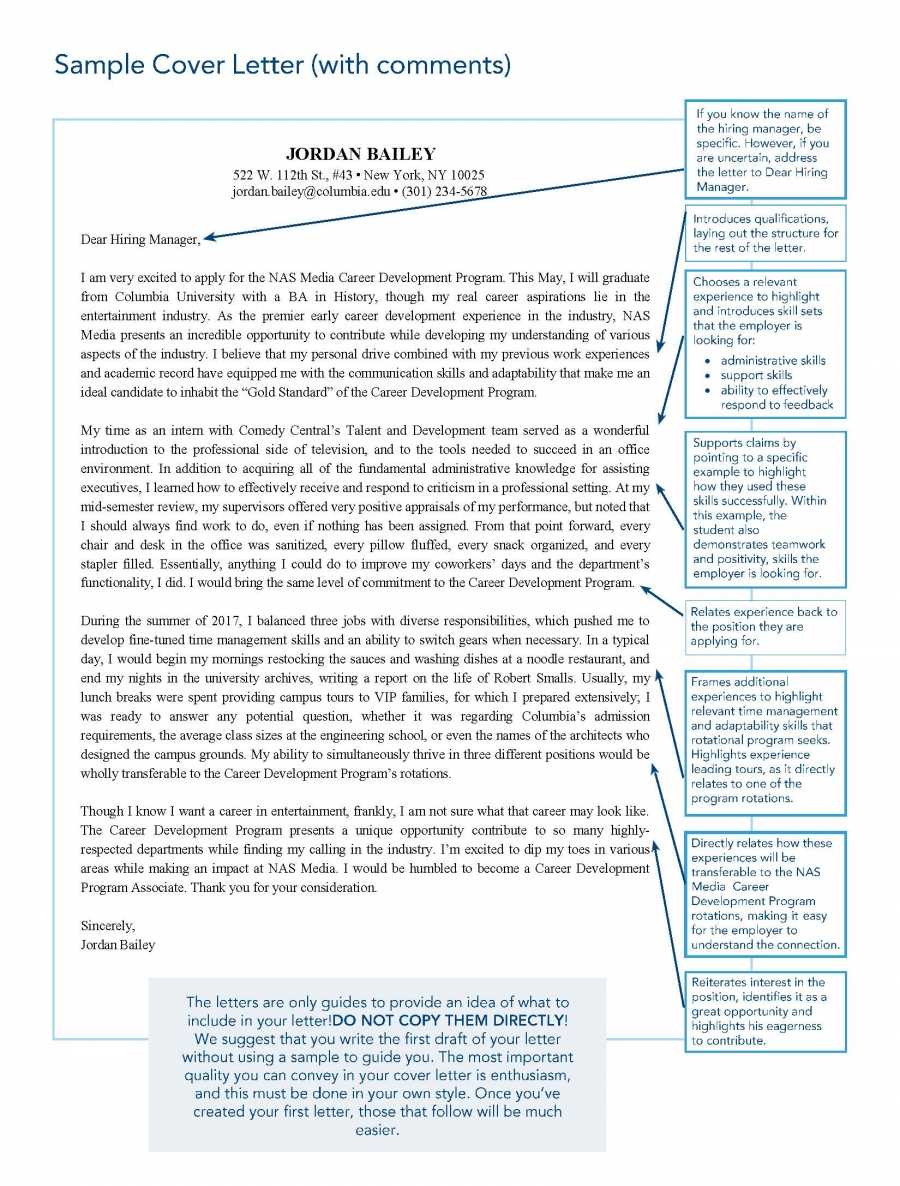
Privacy Policy Accessibility Notice of Non-Discrimination Terms of Use

Cover Letters
Writing a cover letter.
The goal of your cover letter is to complement your resume. Employers use cover letters to determine your interest in the position and company, as well as to assess your written communication skills.
Your cover letter should be clearly structured and answer the following questions:
Who are you?
Introduce yourself. Include your major and year at Georgetown.
Why are you writing?
In the first few sentences, mention the specific job title, if you know it, and how you heard about the position opening. Be concise.
Why are you interested in the position?
Without getting too personal, relate something about the job to your own interests or experiences to show the employer that you have a genuine interest. Do not focus on what this job will do for you unless you are directly asked to answer that question. Instead, focus on what you can contribute to the company.
How are you qualified?
Highlight skills and achievements that demonstrate why you are qualified for the position, and use key terms from the description that are relevant to your background.
What is your next step?
In closing, you should request an interview, with a strong reminder as to why the employer should meet with you. Also, consider adding a statement saying that you will follow up (e.g., within two weeks) to confirm that she has received your resume and cover letter. Skip this step if they’ve requested that you do not contact them.
Cover Letter Tips:
- Customize the cover letter for a specific employer and job description. Templates are easy to spot and indicate you don’t really care about this opportunity in particular.
- Address the letter to a specific individual. If no name was given in the job announcement, call the organization to learn who is on the hiring team. If all else fails, use “Dear Hiring Manager:” or “Dear Search Committee:” (please note that those are colons, not commas).
- Isolate three or four skills that you possess that are relevant to the position and mention concrete examples from your resume that demonstrate these skills.
- Be brief! An ideal cover letter will be three to four concise paragraphs and only be one page.
- Align all text on the left margin. Don’t indent your paragraphs.
- Match the font style and formatting of your resume to your cover letter.
- Proofread several times and ask friends to help!
Cover Letter Formatting
A cover letter should first and foremost represent you and your experiences in an authentic way. This includes writing style and formatting. However, this outline may give you a place to start. Also, be sure to have someone else review your document for content and flow!
Heading (Ensure this matches the heading you use on your resume as it creates a personal brand. This should include your present address, city, state, zip code, phone number, and email address.)
(Align all text on the left margin.)
Employer’s Name (This can also be the name of the recruiter, or director of the department.)
Organization Name
Street Address
City, State Zip Code
Dear Employer’s Name : (It is important to personalize your cover letter by using an actual name. Utilize Handshake, LinkedIn, or call the organization directly to find this information.)
(First paragraph) Introduce yourself. Indicate the reason you are writing, the specific position for which you are applying, and how you heard about the opening. Briefly express why you are interested in the position, or why you are applying to this company in particular. If you are inquiring about jobs in general, and if no specific opening exists, indicate your interest in career opportunities within your desired field. You may also find it helpful to write a “thesis statement” as your final sentence, which will guide the reader through the rest of your document.
(Second paragraph) Highlight your education and/or skills. This could mean including information on your major, research projects, relevant coursework, study abroad, or other Georgetown experiences. Be sure to connect these highlights to the position you are applying for. Keep in mind, these do not have to be content matches but can include skills such as communication, writing, critical analysis, quantitative, etc.
While some students will focus the entirety of this paragraph on education, consider whether or not this is a good fit for you. If it makes more sense to first highlight professional accomplishments or other activities because it will make you a stronger candidate, then it is important to do so.
(Third paragraph) Highlight your professional accomplishments. This could include paid positions, internships, volunteer work, extracurricular activities, athletics, etc. Look at your resume, and choose three or four achievements that demonstrate skills the employer is looking for. Look back at the job description for key terms, and think about where you have demonstrated that qualification or skill.
(Fourth paragraph) The closing. Refer the reader to your resume. Request an interview (if appropriate) and give a final reason or summary statement about why the employer should consider you as a candidate. Thank the employer for considering you for the position.
Your signature (If submitting your cover letter online, you don’t need to include a signature)
Your typed name
Sample Cover Letters
- Download our sample cover letter to see a properly formatted, well-written example of a successful cover letter.
- To see additional cover letter samples, visit Resume Worded and sign in with your Georgetown email address.
- Resume Templates Simple Professional Modern Creative View all
- Resume Examples Nurse Student Internship Teacher Accountant View all
- Resume Builder
- Cover Letter Templates Simple Professional Modern Creative View all
- Cover Letter Examples Nursing Administrative Assistant Internship Graduate Teacher View all
- Cover Letter Builder
University cover letter example

Introduction of a university cover letter
University cover letter body.
Most people go to a university to study, but some go to a university to work. Whether you’re an astrophysics professor, a football coach, or a food service worker, a compelling university cover letter is a crucial part of your application for any college job.
And these jobs are not exactly scarce. One website that specializes in jobs in academia, HigherEdJobs , says that there are more than 92,000 positions at over 2,000 institutes available.
This guide, along with the corresponding cover letter example, will explore how to create the best cover letter for university applications.
University full text-only cover letter example
Dear Mr. Brawley,
During my seven years as Head of Modern Languages at Northwestern, we saw a 35% uptick in admissions and 25% improvement in overall grades. The oriental studies programme was 150% oversubscribed and 95% of all our professors published critically acclaimed research in industry-leading linguistic journals.
Moving to Austin with my family brings opportunities, and while I am happy to explore a move back into academia, the timing of the Head of Modern Languages role at the University of Texas seems perfect. I know that you are looking to grow your oriental and middle east studies departments and I trust that my experience may prove beneficial.
Students are attracted to a degree course primarily because of the diversity of curriculum and the range of options for further study. Language professors with experience of teaching courses around the cultural and historical aspects of their respective countries proved the most popular at Northwestern and it is exactly this combination that will likely help to propel the success at Texas.
Interest in studying obscure linguistics and ancient poetry has dwindled as these regions become global economic powerhouses. Students want to study things that will be relevant to their interactions with real people. That is what underpins the success of any modern languages department. I am an active participant in these academic circles and am confident that I could assist in attracting some top teaching talent to the Texas team.
I have presented at over 100+ international seminars over the past five years, raising the prestige of my university and I would hope to continue in exactly the same vein. Being proactive in exploring the issues of the day and using social media to amplify the messages is the greatest student recruiting tool that any university department can use.
I would welcome the opportunity to share my thoughts on how I might help the Texas Modern Languages department to thrive.
Sandra Hangleton
Sections of a university cover letter
The format of a university cover letter is defined by its key sections, its structure, and its text volume. In most cases, a university cover letter should be one page only , with a maximum of 300 words. Unlike a 100,000-word doctoral dissertation, a cover letter prizes brevity and economy of words.
But those words need to be chosen carefully, and they need to follow a recognized structure.These are the six key elements in the format of a university cover letter:
- Cover letter header . This is where you’ll list your contact details and the date to set up your letter.
- Greeting . Make a personal connection by addressing your letter to the hiring manager or recruiter’s name if possible.
- Introduction . Kick off your letter by introducing yourself and your interest in the role.
- Body . This is where you’ll spend the majority of your word budget. Share your relevant experience, top skills, and biggest achievements. Show the reader how your background aligns with the role they’re looking to fill.
- Conclusion . Close your letter by crafting a summary of your qualifications and reiterating your interest and excitement for the role. Use a compelling call to action.
- Signature . Sign off with a professional goodbye, and, of course, your name.
While they’re all different, each section of your cover letter is an important part of your overall professional narrative.
Need more inspiration? View our other related cover letter examples from the education sector:
- Nanny cover letter
- Graduate cover letter
- Tutor cover letter
- Teacher cover letter
- Internship cover letter
- Scholarship cover letter
- Librarian cover letter
- Library Assistant cover letter
- Elementary Teacher cover letter
- Substitute Teacher cover letter
- Student cover letter
- Teaching Assistant cover letter
- Apprenticeship cover letter
Our article on how to write a cover letter offers more general cover letter information.
After you set up your header and address your letter , it’s time to captivate the reader with your introduction.
To catch a fish, you have to throw out some enticing bait. So, when you kick off your cover letter , the opening paragraph should identify the job you’re seeking and make a convincing case that you’re the right person to fill it.
For a university application, mentioning your top-notch alma mater may be one way to bait the hook. If you have years of experience in your field, that may be another. Lead with your strengths, and write a paragraph that makes it impossible for the recruiter to stop reading.
During my seven years as Head of Modern Languages at Northwestern, we saw a 35% uptick in admissions and 25% improvement in overall grades. The Asian Studies program was 150% oversubscribed and 95% of all our professors published critically acclaimed research in industry-leading linguistic journals.
Hello, my name is Sandra and I am interested in the opening at your university. I have over three years of experience.
Make this space count by choosing a vivid example of a past accomplishment that illustrates your talents in action. For instance, if you led an initiative that increased university admissions by 35%, mention that right off the bat. Using this type of specific, quantifiable metric adds credibility to your experience.
Follow a clear template in the body of your cover letter:
- Highlight your talents, experience, and skills
- Show how you're a perfect fit for the culture of the university. This is important regardless of what role you’re seeking.
- Close out with a conclusion that packs a punch
- Finish with a call to action that makes the hiring manager excited to contact you
First body paragraph: your suitability for the role (skills & experience)
The body of your cover letter—i.e., the middle paragraphs—should contain the heart of your pitch. If your introduction has hooked the fish, the body is where you reel it in. Tailor your cover letter to the university’s culture and mission, so do your research.
Given a one-page limit, list your top qualifications for the job you want. Again, this will usually include experience in your field, and in a university cover letter, it will generally address your education.
Be specific about your work experience, using figures wherever possible, and relate at least one anecdote about how you solved a problem in a previous job. Consider the following as you structure your narrative:
- Highlight your education . Universities value education, so showcase your educational background.
- Emphasize your communication skills . Working at a university requires strong communication, both verbal and written, so display that.
- Showcase public service & customer experience skills . Bring to life your experiences working with diverse communities. Many university roles include working with others, whether or not you’re teaching a class.
- Reference your research skills . Even if you aren’t applying for a researcher role, many universities prioritize the ability to hunt down and analyze information.
- Display your ability to teach others . Not all university jobs require teaching, but the ability to train and coach others is a positive in any role.
- Show off your role-specific expertise . Whichever role you’re targeting likely has its own requirements, so clarify how your background aligns with them.
Especially if you’re applying to a public institution, you’re likely to uncover the name of the hiring manager on the university’s website. The website may even display a bio that shares more about the person’s background, giving you anecdotes to reference in your cover letter.
If you reach a dead end on the university’s website, try searching on LinkedIn and using the hiring manager’s LinkedIn profile to learn more about them.
Second body paragraph(s): alignment with the organization
Reference the name of the university where you’re applying and explain what it is that makes you want to work there. Let the employer know that you aren’t just mass-mailing job applications to random universities, but that you specifically want to work for this one. Start by understanding their mission statement.
For example, the University of Texas ’s mission statement includes:
- Advancing society via research, knowledge, and creativity
- Providing superior educational opportunities
- Serving students and providing beneficial public services
- Transforming lives to benefit society
Incorporate the specifics from the university’s mission into the body of your cover letter and show how your own values and experiences align.
Call to action & conclusion: Finish off strong
Close out your cover letter with a reiteration of your key points and your excitement about the position.
Add an enticing call to action for the hiring manager to reach out and discuss how your background and interests are in line with the university’s goals.
Express your gratitude to the reader for considering your application and taking the time to read it. This shows you have good manners, of course, but also reaffirms your interest in the position.
Finally, finish off this section with a clear invitation for further engagement in the hiring process.
Sign off with your name . More than just a formality, this is your final touch and last chance to leave a memorable impression.
Cover letter mistakes to avoid
Here are some mistakes you want to avoid in your university cover letter:
- Typos, misspellings, and bad grammar . Remember, you’re writing to a university. In a one-page letter, you can’t afford even one writing mistake.
- Copy-paste letters . Sending the exact same cover letter to multiple employers is a recipe for failure. Customize each cover letter for each employer and speak to its specific needs.
- Wasted words . Irrelevant info, clichés, and fluff will fill your page with useless language. Devote the precious space you have to using original language that addresses what makes you a great candidate for this job.
- Design fails . A poorly designed header, a font too small to read, or any other design and formatting errors can lead to rejection the moment the recruiter opens your letter.
How to write a university cover letter with no experience
If you hope to earn a university job but don’t yet have experience, whether that’s due to transitioning from another field or being a student with limited work history, you can still set yourself up for success.
Focus on transferable skills and consider the following:
- Highlight transferable skills . Show how skills and experience from past roles are relevant to this one. For example, skills like customer service as well as strong communication and interpersonal skills are useful in any position.
- Showcase organizational abilities . It’s exceptionally useful to be able to organize projects, systems, people, or spaces, so display these skills if you have them.
- Emphasize technological proficiency . Some universities are very focused on innovation and technology, so use this space to showcase any technical skills you have. Even if they’re self-taught, that shows your commitment to continuous learning.
- Mention any research experience . Have you done deep dives into topics in order to understand them or convey information to others? Have you led research projects or published papers in school?
- Include academic experience . Mention your education, especially from this or other universities. If your education is specifically relevant to the job to which you’re applying, list some of the most relevant courses you took.
- Express your passion for innovation and knowledge . Universities are known for innovating and fostering a culture of knowledge, so share if this resonates with you.
These points will help balance out the lack of direct experience in your cover letter and illustrate your potential, giving you the best chance to land the job.
Consider ATS
An applicant tracking system (ATS) is a tool many companies use to collect and track job applications. Some advanced systems utilize algorithms to scan and rank resumes based on how well they meet the requirements of the job. While your cover letter may not be the focus of the system, it helps to ensure you’re using the right language.
Review the job posting and notice frequently used words or those that seem significant. If they’re relevant to you, incorporate them into your cover letter.
The ATS algorithm sorts through candidates’ applications by scanning for specific keywords.
- “Research experience”
- “Master’s degree”
- “Teaching and training”

Key takeaways
A well-organized cover letter for university applications can be a powerful tool. Use this letter as a way to highlight your relevant skills and experience.
Following the tried-and-tested cover letter format detailed here, you’ll showcase your unique strength . If you’re lacking direct experience, show off your transferable skills and eagerness to learn.
Using our cover letter builder is a simple way to assemble a polished, professional university cover letter, helping you land the job of your dreams.
Free professionally designed templates
University cover letter examples
If you’re applying for jobs at a university, you need a cover letter that will make you stand out amongst all the other qualified candidates.
It’s key that you present yourself in a manner that will persuade the recruitment team to shortlist you for interview, and to help you impress, we’ve put together this detailed guide on how to write a standout cover letter.
We’ll share all our expert advice, along with some university cover letter examples to inspire you.
CV templates
University cover letter example 1
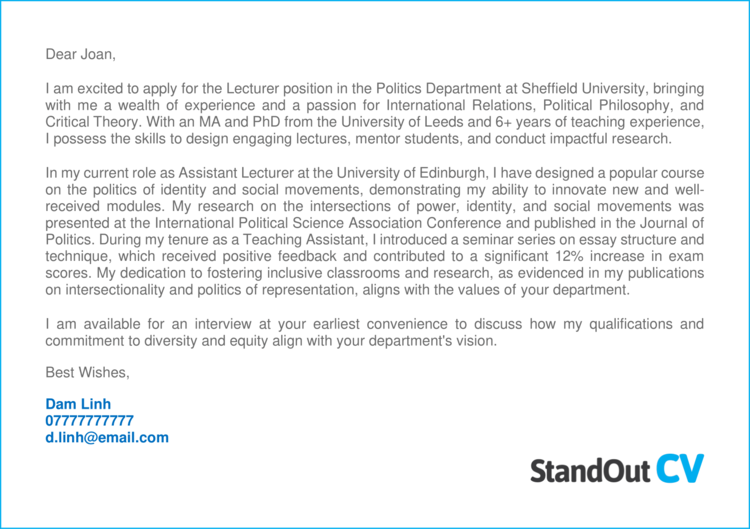
Build your CV now
University cover letter example 2
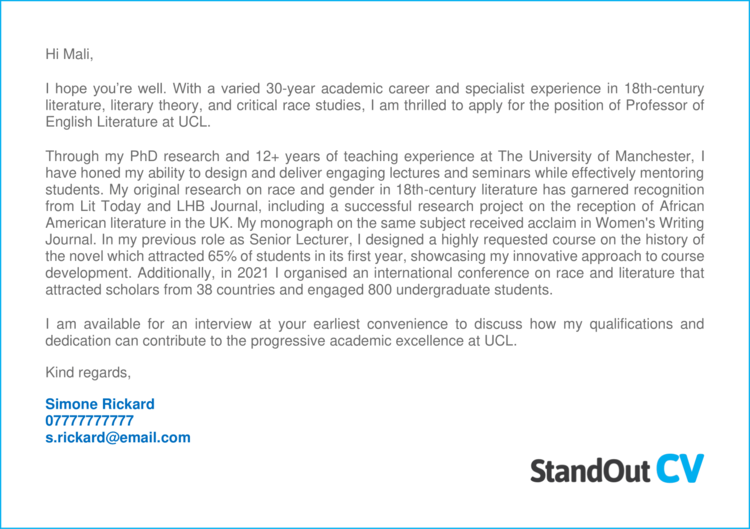
University cover letter example 3
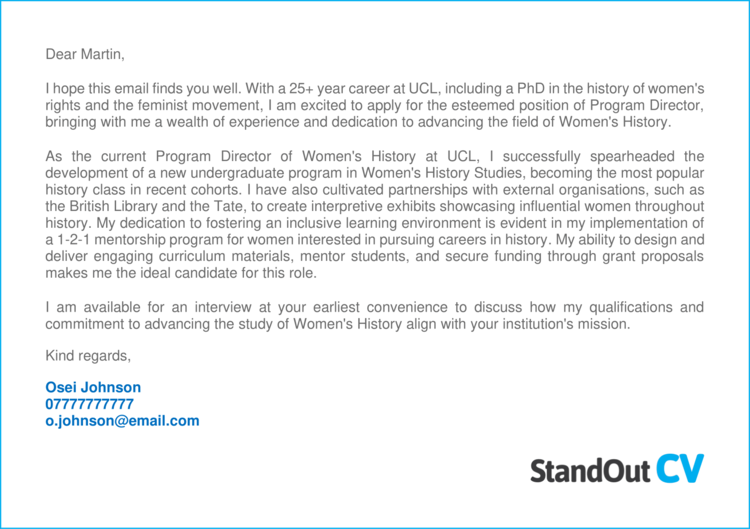
These University cover letter examples provide you with some guidance and inspiration for writing a cover letter that gets noticed and ensures your CV will get opened.
But if you really want to master the art of writing a winning cover letter , then follow our step-by-step cove letter writing guide below.
How to write a University cover letter
A simple step-by-step guide to writing your very own winning cover letter.

Write your cover letter in the body of an email/message
Type the content of your cover letter directly into the email you are sending, or if you are applying via a job board, directly into their messaging system.
The reason for doing this it to ensure that your cover letter gets seen instantly and you can start connecting with the recruiter as soon as they open your message.
If you attach your cover letter as a separate document, the recipient will have to open up the document, which will slow the process down, or make them less likely to even open your cover letter – which could mean your application gets skipped over.

Start with a friendly greeting

To start building rapport with the recruiter or hiring manager right away, lead with a friendly greeting.
Try to strike a balance between professional and personable.
Go with something like…
- Hi [insert recruiter name]
- Hi [insert department/team name]
Stay away from old-fashioned greetings like “Dear sir/madam ” unless applying to very formal companies – they can come across as cold and robotic.
How to find the contact’s name?
Addressing the recruitment contact by name is an excellent way to start building a strong relationship. If it is not listed in the job advert, try to uncover it via these methods.
- Check out the company website and look at their About page. If you see a hiring manager, HR person or internal recruiter, use their name. You could also try to figure out who would be your manager in the role and use their name.
- Head to LinkedIn , search for the company and scan through the list of employees. Most professionals are on LinkedIn these days, so this is a good bet.
Identify the role you are applying for
Once you’ve opened up the cover letter with a warm greeting to start building a relationship, it is time to identify which role you want to apply for.
Recruiters are often managing multiple vacancies, so you need to ensure you apply to the correct one.
Be very specific and use a reference number if you can find one.
- I am interested in applying for the position of *University position* with your company.
- I would like to apply for the role of Sales assistant (Ref: 406f57393)
- I would like to express my interest in the customer service vacancy within your retail department
- I saw your advert for a junior project manager on Reed and would like to apply for the role.
See also: CV examples – how to write a CV – CV profiles
Highlight your suitability
The sole objective of your cover letter is to motivate recruiters into to opening your CV. And you achieve this by quickly explaining your suitability to the roles you are applying for.
Take a look at the job descriptions you are applying to, and make note of the most important skills and qualifications being asked for.
Then, when crafting your cover letter, make your suitability the central focus.
Explain why you are the best qualified candidate, and why you are so well suited to carry out the job.
This will give recruiters all the encouragement they need to open your CV and consider you for the job.

Keep it short and sharp
It is best to keep your cover letter brief if you want to ensure you hold the attention of busy recruiters and hiring managers. A lengthy cover letter will probably not get read in full, so keep yours to around 3-6 sentences and save the real detail for your CV.
Remember the purpose of your cover letter is to quickly get recruiters to notice you and encourage them to open your CV, so it only needs to include the highlights of your experience.
Sign off professionally
To finish off your cover note, add a professional signature to the bottom, stating your important contact details and information.
This not only provides recruiters with multiple means of contacting you, but it also adds a nice professional appearance to the cover letter, which shows that you know how to conduct yourself in the workplace.
Include the following points;
- A friendly sign off – e.g. “Warm regards”
- Your full name
- Phone number (one you can answer quickly)
- Email address
- Profession title
- Professional social network – e.g. LinkedIn
Here is an example signature;
Warm regards,
Aaron Smith Customer service professional 075557437373 [email protected] LinkedIn
Quick tip : To save yourself from having to write your signature every time you send a job application, you can save it within your email drafts, or on a separate document that you could copy in.

What to include in your University cover letter
Your University cover letter will be unique to your situation, but there are certain content guidelines you should stick to for best results.
To attract and entice recruiters, stick with the following key subjects in your cover letter – adapting them to fit your profession and target jobs.
- Your professional experience – Employers will be keen to know if your experience is suitable for the job you are applying to, so provide a good summary of it in your cover letter.
- Your qualifications and education – Highlight your most relevant and high-level of qualification, especially if they are essential to the job.
- The positive impact you have made – Employers love to hear about the benefits you can bring to them, so shout about anything impressive you have done, such as saving money or improving processes.
- Your reasons for leaving – Use a few words of your cover letter to explain why you are leaving your current job and ensure you avoid any negative reasons.
- Your availability – Let recruiters know when you can start a new job . Are you immediately available, or do you have a month notice period?
University cover letter templates
Copy and paste these University cover letter templates to get a head start on your own.
I am excited to apply for the Lecturer position in the Politics Department at Sheffield University, bringing with me a wealth of experience and a passion for International Relations, Political Philosophy, and Critical Theory. With an MA and PhD from the University of Leeds and 6+ years of teaching experience, I possess the skills to design engaging lectures, mentor students, and conduct impactful research.
In my current role as Assistant Lecturer at the University of Edinburgh, I have designed a popular course on the politics of identity and social movements, demonstrating my ability to innovate new and well-received modules. My research on the intersections of power, identity, and social movements was presented at the International Political Science Association Conference and published in the Journal of Politics. During my tenure as a Teaching Assistant, I introduced a seminar series on essay structure and technique, which received positive feedback and contributed to a significant 12% increase in exam scores. My dedication to fostering inclusive classrooms and research, as evidenced in my publications on intersectionality and politics of representation, aligns with the values of your department.
I am available for an interview at your earliest convenience to discuss how my qualifications and commitment to diversity and equity align with your department’s vision.
Best wishes,
I hope you’re well. With a varied 30-year academic career and specialist experience in 18th-century literature, literary theory, and critical race studies, I am thrilled to apply for the position of Professor of English Literature at UCL.
Through my PhD research and 12+ years of teaching experience at The University of Manchester, I have honed my ability to design and deliver engaging lectures and seminars while effectively mentoring students. My original research on race and gender in 18th-century literature has garnered recognition from Lit Today and LHB Journal, including a successful research project on the reception of African American literature in the UK. My monograph on the same subject received acclaim in Women’s Writing Journal. In my previous role as Senior Lecturer, I designed a highly requested course on the history of the novel which attracted 65% of students in its first year, showcasing my innovative approach to course development. Additionally, in 2021 I organised an international conference on race and literature that attracted scholars from 38 countries and engaged 800 undergraduate students.
I am available for an interview at your earliest convenience to discuss how my qualifications and dedication can contribute to the progressive academic excellence at UCL.
Kind regards,
Simone Rickard
Dear Martin,
I hope this email finds you well. With a 25+ year career at UCL, including a PhD in the history of women’s rights and the feminist movement, I am excited to apply for the esteemed position of Program Director, bringing with me a wealth of experience and dedication to advancing the field of Women’s History.
As the current Program Director of Women’s History at UCL, I successfully spearheaded the development of a new undergraduate program in Women’s History Studies, becoming the most popular history class in recent cohorts. I have also cultivated partnerships with external organisations, such as the British Library and the Tate, to create interpretive exhibits showcasing influential women throughout history. My dedication to fostering an inclusive learning environment is evident in my implementation of a 1-2-1 mentorship program for women interested in pursuing careers in history. My ability to design and deliver engaging curriculum materials, mentor students, and secure funding through grant proposals makes me the ideal candidate for this role.
I am available for an interview at your earliest convenience to discuss how my qualifications and commitment to advancing the study of Women’s History align with your institution’s mission.
Osei Johnson
Writing an impressive cover letter is a crucial step in landing a job working at a University, so taking the time to perfect it is well worth while.
By following the tips and examples above you will be able to create an eye-catching cover letter that will wow recruiters and ensure your CV gets read – leading to more job interviews for you.
Good luck with your job search!
- Career Center Team
- Meet the Career Coaches
- Meet the Career Center Student Employees
- Locations and Parking Information
- High School Career Connect
- College Career Communities
- Affinity Communities
- Job Families
- Graduate Students
- On-Campus Interviews
- On-Campus Jobs
- UCAR Career Readiness
- Internship Program
- Avoiding Job Scams
- Recruit at UNT/Build a Presence
- Employer Recruiting Policies and Procedures
- Career Center Employer Advisory Board
- Employer Partnership Program
- Supervisors for On Campus Jobs
- Posting an On Campus Job
- Career Presentations for Classes and Other Groups
- Mock Interviews
- Faculty Toolkit
- Identify Your Skills and Interests
- Graduate School Planning
- Career Fair Prep
- Internships
Cover Letters
- Share This: Share Cover Letters on Facebook Share Cover Letters on LinkedIn Share Cover Letters on X
A Cover Letter is often required as part of the application process. If you submit one, it should sum up how your experiences fit the requirements of the position. A brief yet impactful cover letter can highlight your accomplishments and encourage the reader to want to learn more about you and what you can offer the organization!
Steps for Writing a Cover Letter
Key points in writing a Cover Letter (Can be the body of an email):
- Typically, three paragraphs
Paragraph 1
- Introduce yourself, briefly identify your academic and employment background, refer to the position, and explain how you heard about the position
- Can also be a letter of interest for future opportunities or that someone has recommended you for the job – give details about the referral
Paragraph 2
- Pick out qualifications from the job description and state how you have demonstrated them. Give specific examples of how your experience aligns with the requirements.
- Write that you have attached or included your resume
Paragraph 3
- Ask for further action and wrap up. An interview, meeting or discussion. Provide contact information and thank the reader.
Additional Resources
- How to Write a Cover Letter
- Four Types of Cover Letters with Samples
Disclaimer | AA/EOE/ADA | Privacy | Electronic Accessibility | Required Links | UNT Home
Cover letter template
Explain to the employer the purpose of your letter, why you’re applying for the job, how you meet the job criteria, and how they can contact you for an interview.
Cover letters for job applications
[your street number and name] [your suburb, state and postcode]
[title and name of addressee] [his/her position title if known]
[organisation’s name] [organisation’s address]
Dear [insert Ms/Mr Xxx or Sir/Madam]
Application for position of [name of role], Reference Number [if given]
OPENING PARAGRAPH(S): The purpose of this letter, and why them.
Paragraph 1 : start by referring to the position you’re applying for (or “I am applying for the above position” if formatted as above) and where you saw the advertisement or heard about the role.
Paragraph 2 : explain why you’re interested in the role and the organisation. In order to do this, you need to have thoroughly read the selection criteria relating to the role and researched the organisation using their website, news sites, industry contacts, and so forth. If you’re applying through a recruitment agency and don't know the name of the hiring organisation, you can research the industry instead. Try to avoid clichés and make your interest in the organisation appear personal and genuine. A brief summary of your key selling points can be included at this point to highlight your ‘organisational fit’.
eg, GreenBuild’s recent exhibit at the Sustainable Cities festival was of particular interest to me as I have a passion for sustainable development. My skills in residential design developed through my Bachelor of Design in Architecture, along with my thorough knowledge of sustainable building practices acquired over two years as a project officer with the NSW Department of Environment and Heritage, would allow me to make a meaningful contribution to your mission to create Sydney’s greenest housing developments.
MIDDLE PARAGRAPHS: Why you?
Paragraph 3 : this is where you provide evidence as to how your qualifications, skills and experience meet the selection criteria for the position. You can draw evidence from a range of experiences if relevant, including academic studies, extracurricular activities, placements, volunteer roles and paid employment history, including casual work. This section where you address the selection criteria should be the longest section in your letter. It may be necessary to divide it into more than one paragraph.
eg, My strong time management skills have been developed through balancing part time work at Bob’s Café with volunteering commitments at my local community centre while meeting all assignment deadlines to maintain a distinction average in my studies.
FINAL PARAGRAPH: Wrap-up
Paragraph 4 : this is where you express the hoped-for outcome of your letter. End on a positive note and a call to further action. You may want to reiterate how your relevant strengths make you a suitable candidate for the role and mention your availability for interview. Refer to any attachments such as resume, transcript, application form, etc.
Yours sincerely [your name typed]
[Note: Use ‘Yours sincerely’ for letters beginning with ‘Dear plus Addressee’s Name’ and ‘Yours faithfully’ for letters beginning with ‘Dear Sir/Madam’]
Speculative cover letters
Speculative cover letters are used when you are proactively seeking opportunities directly with an employer, rather than responding to advertised vacancies. For speculative letters, follow the format above, with the following adjustments:
Opening paragraph : If you’ve been referred by a friend or colleague known to the recruiter, mention this. As no job has been advertised, state that you’re seeking employment opportunities in a particular occupational area or role.
Final paragraph : You may wish to include your intention to contact the employer on a particular day to follow up. Make sure that you keep your promise by noting the date in your diary and contacting the addressee on the mentioned date, as planned.
Need more cover letter tips?
How to write a cover letter.
A cover letter is your first introduction to a potential employer, so it needs to show that you’re a suitable candidate.
Addressing selection criteria
Selection criteria are the skills, knowledge, and experience required to successfully do the job.
How to write a resume
A clear, tailored and professional resume is essential for any job application. It should aim to convince an employer that your qualifications, work experience and skillset make you a strong match for the job.
How to Write an Academic Cover Letter With Examples
PeopleImages.com / Getty Images
- Cover Letters
- Skills & Keywords
- Salary & Benefits
- Letters & Emails
- Job Listings
- Job Interviews
- Career Advice
- Work-From-Home Jobs
- Internships
- How to Write an Academic Cover Letter
Be Prepared for Faculty Review
Target your cover letter, cover letter format.
- Cover Letter Example & Template
Requred Job Application Materials
Submitting your application.
When you are applying for a faculty position at a college or university, your cover letter will differ significantly from the standard business cover letter.
Your cover letter may be reviewed by Human Resources department staff to determine if you meet the basic qualifications for the job. If it does, it will be forwarded to a search committee comprised mostly of faculty members and academic deans.
These individuals will be accustomed to reading more lengthy academic cover letters and resumes or curriculum vitae (CV) than would be customary in the business world. They will also often be more interested in the philosophical foundations for your work than the typical business recruiter.
Kelly Miller / The Balance
Tips for Writing an Academic Cover Letter
Your initial challenge will be to pass through the Human Resources screening. Review each of the required qualifications included in the job announcement and compose statements containing evidence that you possess as many of the skills, credentials, knowledge, and experiences listed as possible.
Address as many of the preferred qualifications as possible.
Give concrete examples to support your assertions about your strengths.
Your faculty reviewers will typically have an interest in your philosophy and approach to teaching and research within your discipline. They will also be evaluating how your background fits with the type of institution where they work.
Research the faculty in your target department to assess their orientation and expertise. Emphasize points of intersection between your philosophy and the prevalent departmental philosophy.
If you possess traditionally valued areas of expertise that are not already represented by the current faculty, make sure to point those strengths out in your cover letter. It's important to tailor your letter to the orientation of the college and adjust the mix of emphasis on teaching and research based on the expectations in that setting.
Colleges will typically want to hire new faculty who are passionate about their current research and not resting on past research credits.
Describe a current project with some detail and express enthusiasm for continuing such work.
Try to do the same with any evolving teaching interests.
Highlight any grants and funding you have received to undertake your research activities. Incorporate any awards or recognition which you have received for your teaching or research activities. Some text should also be devoted to other contributions to the college communities where you worked, such as committee work, advising, and collaborations with other departments.
Your cover letter should be written in the same basic format as a business cover letter. An academic cover letter is typically two pages compared to a single page for non-academic letters.
Here’s an example of the appropriate format for a cover letter and guidelines for formatting your letters.
Academic Cover Letter Example
You can use this sample as a model to write an academic cover letter. Download the template (compatible with Google Docs and Word Online), or read the text version below.
Academic Cover Letter Example #1 (Text Version)
Robin Applicant 123 Main Street, Anytown, CA 12345 555-555.5555 robin.applicant@email.com
April 5, 2021
Dr. Sylvia Lee Chair, English Department Search Committee Acme College 123 Business Rd. Charlotte, NC 28213
Dear Dr. Sylvia Lee,
I am writing to apply for the position of assistant professor of English with an emphasis in nineteenth-century American literature that you advertised in the MLA Job Information List. I am a Dean’s Fellow and Ph.D. candidate at XYZ University, currently revising the final chapter of my dissertation, and expecting to graduate in May I am confident that my teaching experience and my research interests make me an ideal candidate for your open position.
Over the past five years, I have taught a variety of English courses. I have taught a number of American literature survey courses, as well as writing courses, including technical writing and first-year writing. I have extensive experience working with ESL students, as well as students with a variety of learning disabilities, including dyslexia and dysgraphia, and disabilities like ADD and ADHD. I pride myself on creating a classroom environment that accommodates the needs of my students while still promoting a high level of critical thought and writing skills. Some of my most satisfying experiences as a teacher have come from helping struggling students to grasp difficult concepts, through a combination of individual conferences, class activities, and group discussion. I know I would thrive as a teacher in your college, due to your belief in small classroom size and individualized support for students.
Not only does my teaching experience suit the needs of your school and department, but my research interests also fit perfectly with your description of the ideal candidate. My dissertation project, “Ferns and Leaves: Nineteenth-Century Female Authorial Space,” examines the rise and development of American female authors in the 1840s and 1850s, with a particular focus on patterns of magazine publication. I argue that, rather than being submissive to the requirements of the editor or publisher, female authors, in fact, developed a more transparently reciprocal relationship between themselves and their readers than previously has been assumed. I apply recent print-culture and book-history theory to my readings of novels, magazine articles, letters, and diary entries by various female authors, with a particular focus on Sara Willis (known by her pseudonym Fanny Fern). I plan to develop my dissertation into a book manuscript and continue to research the role of female writers in antebellum magazine culture, with a particular focus on the rise and influence of female magazine editors on literary culture.
My research interests have both shaped and been shaped by my recent teaching experiences. Last spring, I developed and taught a course on the history of print culture in America. I combined readings on theory and literature that addressed issues of print with visits to local historical museums and archives. My students conducted in-depth studies on particular texts (magazines, newspapers, novels) for their final papers. I believe my interdisciplinary teaching style, particularly my emphasis on material culture, would fit in well with the interdisciplinary nature of your English department.
I am therefore confident that my teaching experience, my skill in working with ESL and LD students, and my research interests all make me an excellent candidate for the assistant professor of English position at ABC College. I have attached my curriculum vitae and the two requested sample publications. I would be happy to send you any additional materials such as letters of reference, teaching evaluations, and past and proposed course syllabi. I will be available to meet with you at either the MLA or C19 conference, or anywhere else at your convenience. Thank you so much for your consideration; I look forward to hearing from you.
Robin Applicant (hard copy letter)
Robin Applicant
Academic Cover Letter Example #2 (Text Version)
Betty Applicant 567 North Street, Boston, MA 02108 555-555.555 betty.applicant@email.com
Dr. Robert Smith Chair, Department of Biology Acme University 123 Business Rd. Business City, NY 54321
Dear Dr. Smith,
I am writing to apply for the position of Assistant Professor of Biology with a focus on molecular biology at XYZ University, as advertised in the March issue of Science. I am currently a postdoctoral fellow at the University of XYZ in the Department of Molecular Biology, working under the advisement of Professor Linda Smith. I am confident that my research interests and teaching experience make me an ideal candidate for your open position.
My current research project, which is an expansion on my dissertation, “[insert title here],” involves [insert research project here]. I have published my dissertation findings in Science Journal and am in the processing of doing the same with my findings from my current research. The laboratory resources at XYZ University would enable me to expand my research to include [insert further research plans here] and seek further publication.
Beyond my successes as a researcher (including five published papers and my current paper in process), I have had extensive experience teaching a variety of biology courses. As a graduate student at Science University, I served as a teaching assistant and guest lecturer for both biology and chemistry introductory courses and won the university award for outstanding teacher’s assistant. As a postdoctoral fellow at the University of ABC, I have had the opportunity to teach Introduction to Biology as well as a graduate-level course, Historicizing Molecular Biology. In every class, I strive to include a blend of readings, media, lab work, and discussion to actively engage students with the material. I would love the opportunity to bring my award-winning lesson planning and teaching skills to your biology department.
I am confident that my research interests and experience combined with my teaching skills make me an excellent candidate for the Assistant Professor of Biology position at XYZ University. I have attached my curriculum vitae, three recommendations, and the two requested sample publications. I would be happy to send you any additional materials such as teaching evaluations or past and proposed course syllabi. I will be available to meet with you at the ASBMB conference or anywhere else at your convenience. Thank you so much for your consideration; I look forward to hearing from you.
Betty Applicant (hard copy letter)
Betty Applicant
It’s important to submit all your application materials in the format requested by the college or university. You may be asked to email, mail, or apply online via the institution’s applicant tracking system.
You may be required to provide references with your application, so be prepared to submit a list of references. The institution may also request transcripts, teaching evaluations, and writing samples.
Send only what is requested. There's no need to include information that the institution hasn't ask for.
However, you can offer to provide additional materials like writing samples, syllabi, and letters of recommendation in the last paragraph of your letter.
Follow the instructions in the job posting for submitting your application. It should specify what format the college wants to receive.
Here are some examples of what you may be asked to include with your cover letter and resume or CV:
- A cover letter, CV/resume, and contact information for three references.
- A cover letter (PDF format) of interest indicating your qualifications and reason for application, Curriculum Vitae (PDF format), and a minimum of three professional references, including phone and email contact information.
- A letter of interest, a Curriculum Vitae, a teaching vision statement, a research vision statement that specifically indicates how you would interact with or collaborate with other department faculty, and three references.
- A cover letter, CV/resume, and contact information for three references. Please upload these as ONE document in RTF, DOC or PDF format.
- Sample Job Cover Letter for a College Summer Assistant Job
- Speech Pathologist Resume and Cover Letter Examples
- Cover Letter Samples for Teachers
- How to Write a Cover Letter for a Construction Management Job
- Administrative Assistant Cover Letter Examples
- Academic Advisor Cover Letter Sample and Writing Tips
- Cover Letter Example - Ecommerce Technology
- Receptionist Cover Letter Examples and Writing Tips
- Director of Operations Cover Letter Example
- Sample Cover Letters for Higher Education Communications
- Special Education Cover Letter: Example and Writing Tips
- Cover Letter Examples for Sales and Marketing Jobs
- Teacher Cover Letter Example and Writing Tips
- Hair Stylist Cover Letter and Resume Examples
- Transportation Planning Cover Letter Example and Writing Tips
- Write Interview Winning Resumes and Cover Letters
- Skip to Content
- Skip to Main Navigation
- Skip to Search

IU Indianapolis IU Indianapolis IU Indianapolis

- What is KICS?
- Meet with Us
- Use Handshake
- Human Resource Management
- International Studies Co-Major
- Real Estate Co-Major
- Supply Chain Management
Cover Letters
- Interviewing
- Job Acceptance & Negotiation
- Internships
- #KelleyHired
- International Student Employment
- Student Guidelines
- Graduate Accounting Career Services
- Evening MBA Career Services
- Kelley Alumni
- KelleyCareers powered by Handshake
- Career & Salary Statistics
- Plan a Campus Visit
- Business Plus
- Start an Internship Program
- Report Your Hire
- Advisory Board
- Employer Recruiting Policies & Procedures
Kelley School of Business
- Centers & Institutes
- News & Resources
- Kelley Store
- Career Services
- Recruiters & Companies
- Student & Alumni Services
- Undergraduate Career Services
- Career Resources
Tell your story.
Your cover letter gives life to your résumé by introducing you, your achievements and your potential to a prospective employer. Review our cover letter guide and cover letter example to help guide you in crafting your own story.
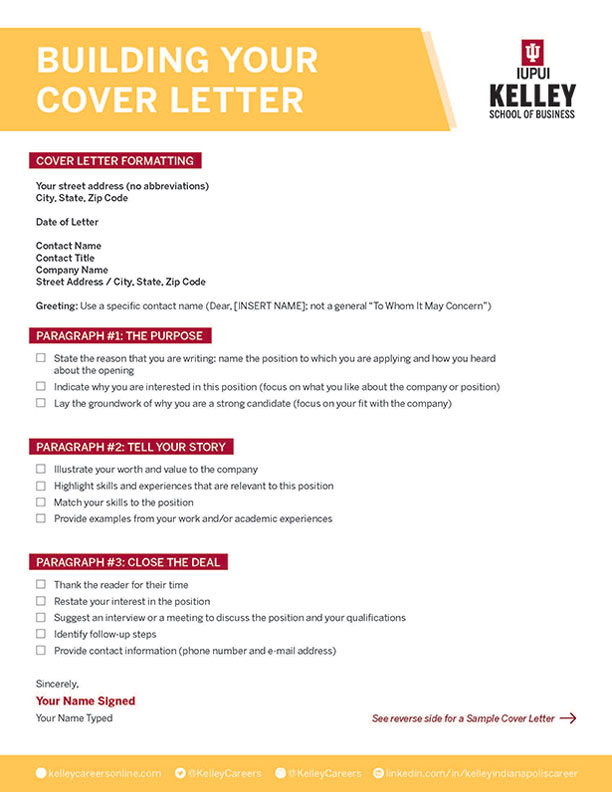
View and download the cover letter guide and example.
Building Your Cover Letter
Kelley cover letter example
Need help creating your cover letter?
Make an appointment with Kelley Indianapolis Career Services.
Schedule an appointment in Handshake.
Meet with us
Contact KelleyCareers
Purdue Online Writing Lab Purdue OWL® College of Liberal Arts
Cover Letters

Welcome to the Purdue OWL
This page is brought to you by the OWL at Purdue University. When printing this page, you must include the entire legal notice.
Copyright ©1995-2018 by The Writing Lab & The OWL at Purdue and Purdue University. All rights reserved. This material may not be published, reproduced, broadcast, rewritten, or redistributed without permission. Use of this site constitutes acceptance of our terms and conditions of fair use.
Introduction
These resources will help you understand and write successful cover letters. To use these pages, you may select links in the navigation bar on the left, you may select links from the list below, or you may advance through the pages using the links at the bottom of each page. Click here to download the PDF file containing sample résumés and employment letters. The cover letter pages are organized into the following sections:
- What is a cover letter?
- Why do I need to do a cover letter?
- What should I do if I'm a veteran transitioning into civilian life?
- What should I do if I'm a transitioning automotive industry worker?
- What should I do about any times I was not working?
- What should I do if I have been incarcerated?
- What should my cover letter look like?
- What should my cover letter accomplish?
- What should I do before I start writing?
- What are the sections I should include in my letter?
- Introductions
- Addressing your letter
- Body paragraphs
- How should I follow up on my cover letter and résumé?
- Carlos Alvarez College of Business
- College of Education and Human Development
- College of Liberal and Fine Arts
- College for Health, Community, and Policy
- College of Sciences
- Klesse College of Engineering and Integrated Design
- University College
- First Generation
- International Students
- Student Athletes
- All Majors Career Expo
- CAREER-A-PALUTSA
- Part Time Job Fair
- STEM Career Expo
- Resources for Students
- Resources for Employers
- Micro-Internships
- Explore + Discover
- Skill Development + Networking
- Document Prep + Search Opportunities
- Additional Resources
- Salary + Industry + Financial Data
- Cultivating Career Confidence
- Faculty and Staff
- Student Advisory Board
- Internship Information
- Recruiting and Branding
- Employer Resources
- Career Events
- Employer Engagement Contact Information
- Meet the Team
- Meet The Career Ambassadors
- Meet the Student Advisory Board
Cover Letter Checklist + Outline (2024)
- Share This: Share Cover Letter Checklist + Outline (2024) on Facebook Share Cover Letter Checklist + Outline (2024) on LinkedIn Share Cover Letter Checklist + Outline (2024) on X
UTSA Career Center
- Campus Alerts
- Open Records
- Report Fraud
- Required Links
© The University of Texas at San Antonio | One UTSA Circle, San Antonio TX 78249 | Information: 210-458-4011 | UTSA Police: 210-458-4242
How to Write an Application Letter (Sample Included!)

Whether you’re applying for a job , internship , scholarship, or volunteer position, a well-crafted application letter can help you stand out. It's your chance to introduce yourself and make a strong first impression that sets you apart from the competition.
But how do you write an application letter that’s effective? Below, we’ll explain when to use this method of introduction and give you practical tips on writing one that gets results. Plus, we've included a sample application letter and a template to help you create the perfect document for any opportunity.
Apply for the role of your dreams! One of these open jobs on The Muse could be the perfect fit »
What is an application letter?
An application letter is a document sent with your resume to provide additional information on your skills and experience. It's a crucial part of an application for work as it introduces you to potential employers and highlights your qualifications.
While some companies request it at the beginning of the application process, others might ask for it later, or not at all—but it's always a valuable addition.
Unlike a resume, which outlines your work history, a written application allows you to elaborate on your achievements and how they relate to the job you are applying for. It is a much more specific way to introduce yourself and explain why you would be a good fit for the job.
How is an application letter different from a cover letter?
Some people use the terms “application letter” and “cover letter” interchangeably, but there are subtle differences between the two.
An application letter serves as your formal introduction to a potential employer. It highlights your interest in the role, your qualifications, and why you're a good fit for the position. It's a standalone document that provides a comprehensive overview of your skills and experiences.
On the other hand, a cover letter is usually more concise than an application letter and serves as a complementary document to your resume, providing additional context to your job application. It elaborates on specific points from your resume and explains how your background aligns with the job requirements.
Also, job application letters follow a more formal structure, often resembling a traditional business letter. They include your contact information, the date, and the employer’s contact information at the top. An application letter is usually addressed to a specific individual, such as the hiring manager or recruiter. While cover letters also have a professional tone, they can be less formal in structure.
Finally, the application letter is used primarily for job applications, internship applications, scholarship applications, and volunteer positions. In contrast, the cover letter is specifically used to accompany a resume during job applications.
When do you need to send an application letter?
Application letters are typically required when applying for jobs. However, there are other scenarios where you might need one:
- Scholarship applications: When applying for scholarships, this kind of letter can help you stand out by showcasing your academic achievements and career goals .
- Volunteer positions: Some volunteer organizations require an application letter to understand your motivations and skills relevant to the position.
- Internship applications: Internships often require this document to understand your interest in the role and what you hope to gain from the experience.
- Networking purposes: Sending one when reaching out to potential mentors or industry professionals can help you establish a connection and explain your career aspirations.
7 tips on how to write a job application letter
Writing an effective application letter involves more than just summarizing your resume. Here are seven tips to write yours:
1. Research the company—at least do a quick Google search!
Before you start writing, research the company to understand its culture, values, and needs. Tailor your letter to align with the company’s mission and the job description. There is nothing better for an HR professional than feeling that you don’t just want any job; you want to work with them for specific reasons, such as X and Y.
“Address the letter to the hiring manager by name if possible,” says Mike Chappell, CEO of FormsPal , who has more than a decade of experience reviewing application letters. “This shows that you’ve done your research and are genuinely interested in the company.”
2. Use a professional format and design
Your application letter should follow a formal letter of application format. Use a standard font like Times New Roman or Arial, and keep the font size between 10 and 12 points. Include your contact information, the date, and the employer’s contact information at the top of the letter.
There are many layouts online that you can use. Find one that represents your style and complements your resume.
3. Make it engaging from the start with a strong opening
Your opening paragraph should grab the reader’s attention. Mention the position you're applying for and where you found the job listing. If you were referred by someone, include their name. Briefly introduce yourself and explain why you’re interested in the role.
4. Highlight your qualifications—what you can’t fully convey in your resume
In the body of your applicant letter, highlight your relevant skills, experiences, and achievements. “Use specific examples to showcase your accomplishments and how they relate to the job you’re applying for,” Chappell says. “ Quantifiable results can make a strong impact.”
Avoid repeating information from your resume; instead, expand on your most relevant experiences.
5. Show enthusiasm and genuine interest
Employers want to hire candidates who are enthusiastic about the role and the company. Show your excitement for the opportunity. Explain why you are specifically interested in this job and how it aligns with your career goals.
6. Keep it concise
While it’s important to provide enough detail, your application letter should be concise. Aim for one page, with three to four paragraphs. Be clear and to the point, avoiding unnecessary fluff.
7. Proofread carefully
Typos and grammatical errors can leave a negative impression on employers. Carefully proofread your letter before sending it. Consider asking another person to review it as well.
Letter of application sample
Here's a super complete example of application letter to help you get started:
August 1, 2024
Ms. Jane Doe
Hiring Manager
Innovative Solutions Inc.
456 Maple Avenue
Springfield, IL 62705
Dear Ms. Doe,
I am writing to express my interest in the Marketing Manager position at Innovative Solutions Inc., as advertised on your company’s careers page. With more than five years of experience in marketing and a proven track record of successful campaigns, I am excited about the opportunity to contribute to your team and drive impactful marketing strategies.
In my previous role as a Senior Marketing Specialist at Creative Solutions LLC, I led a team in developing and executing a comprehensive marketing strategy that resulted in a 30% increase in brand awareness and a 25% boost in lead generation. My responsibilities included overseeing digital marketing campaigns, analyzing market trends, and coordinating with cross-functional teams to ensure alignment with overall business goals. This experience has honed my skills in strategic planning, data analysis, and team leadership.
I am particularly impressed by Innovative Solutions Inc.’s commitment to leveraging cutting-edge technology to deliver innovative marketing solutions. Your recent campaign, which utilized artificial intelligence to optimize ad targeting, is a testament to your forward-thinking approach. I am eager to bring my expertise in digital marketing and campaign management to your team and contribute to similar groundbreaking projects.
My strong analytical skills, combined with my ability to lead and inspire a team, make me a great fit for this role. I am confident that my background and enthusiasm for innovative marketing strategies align well with the needs of Innovative Solutions Inc.
Thank you for considering my application. I look forward to the opportunity to discuss how my skills and experiences can contribute to the continued success of Innovative Solutions Inc.
123 Elm Street
Springfield, IL 62704
(555) 123-4567
Template for an application letter
You can also use the following application format to structure your application letter for a job:
[Recipient’s name]
[Company’s name]
[Company’s address]
[City, State, ZIP Code]
Dear [Recipient’s name],
I am writing to express my interest in the [Job title] position at [Company name] as advertised on [Where you found the job listing]. With my background in [Field or industry] and a passion for [Specific aspect of the job or industry], I am excited about the opportunity to contribute to your team.
In my previous role at [Previous company], I developed [Specific skills or achievements]. I successfully [Describe a project or responsibility], which resulted in [Quantifiable result or achievement]. This experience has equipped me with [Relevant skills] that I am eager to bring to [Company name].
I am particularly impressed by [Company name]’s commitment to [Specific company initiative or value], and I am enthusiastic about the prospect of working with a team that values [Related value or skill]. I am confident that my skills and experiences align well with the requirements of the [Job title] position.
Thank you for considering my application. I look forward to the opportunity to discuss how my background, skills, and enthusiasm can contribute to the success of [Company Name].
[Your Name]
[Your address]
[Your email address]
[Your phone number]
Common mistakes to avoid
When writing a letter of application for employment, be aware of these common mistakes:
- Being too generic: Focus your letter on the specific job and company, and mention detailed information about them. Don’t default to a one-size-fits-all approach or AI-written document. “It is generally best to avoid using generative AI to write your application letters for you,” says Edward Tian, CEO of AI detector GPTZero . “Only you can write about those specific aspects of your identity and experiences in such a personal way.”
- Focusing too much on yourself: While it’s important to highlight your qualifications, make sure to explain how you can benefit the company. “You can talk about your career goals, college classes that piqued your interest in the type of job you're applying to—just make sure that they tie into why they make you uniquely qualified or well-positioned for the job,” Tian says.
- Including irrelevant information: Avoid discussing unrelated jobs or hobbies, for example.
- Using a casual tone: Maintain a professional tone throughout your letter. Avoid slang or overly casual language.
Need a bit more guidance in your job search? Read this next: How to Apply for a Job Online: 10 Tips to Stand Out and Land an Interview
How-To Geek
Mail merge is more useful than you think: 4 practical uses.

Your changes have been saved
Email is sent
Email has already been sent
Please verify your email address.
You’ve reached your account maximum for followed topics.
If Your PC Won't Run Windows 11, Here Are 5 Great Linux Operating Systems to Try Instead
Which linux distro is most like windows, how to make a bootable linux usb drive on any computer with balena etcher, quick links, creating address labels for your wedding invitations and christmas cards, writing individualized reports, writing job application cover letters, designing certificates.
Mail merging in Microsoft Word is well known for letting you create and send personalized versions of the same email to lots of people in one go. However, the tool also has some practical everyday uses that could make your home and work life a lot easier.
In short, mail merge lets you create a document in Microsoft Word that you can personalize with individualized details , such as people's names. There are two ways to do this—you can create the list of personalized variables within Microsoft Word's mail merge feature itself, or you can create the list in another program, such as Excel, and then import the details from that list into Word.
In this article, we will show you how to use mail merge in Microsoft Word alongside Microsoft Excel, since creating comprehensive lists and databases in Excel is easier to do and manage.
Mail merge is currently not available in Word for the web—you will need to subscribe to Microsoft 365 and use the Microsoft Word desktop app to use this tool.
While enjoyable, sending wedding invitations or Christmas cards can take time, and it's easy to make mistakes, especially if you're writing the addresses on the envelopes by hand. This is why you should use Microsoft Word instead. When you're done, you can either print the names and addresses onto label paper, or use normal paper and glue, before cutting out the individual labels to stick to your envelopes.
Start in Excel by creating your list of names and addresses. Make sure you put each line of each person's name and address into separate columns, and use headings across row 1. Also, ensure that you populate all cells, as leaving blanks will cause issues with your mail merge down the line.
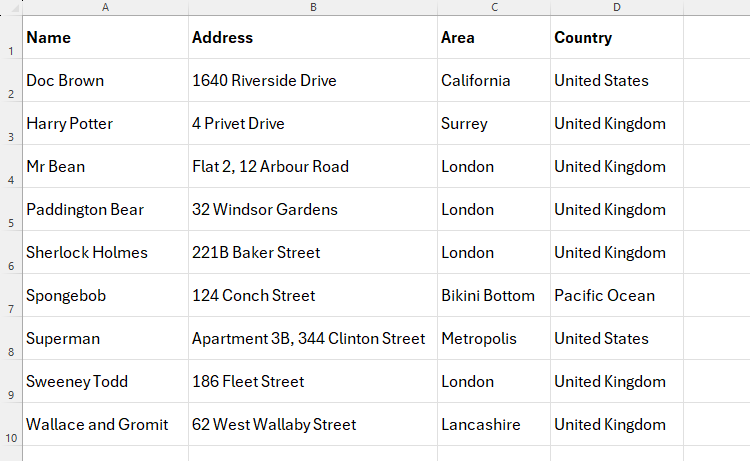
Then, press F12 to name and save your document in a memorable place on your computer.
Now, open a blank Word document, and click Mailings > Start Mail Merge > Labels.
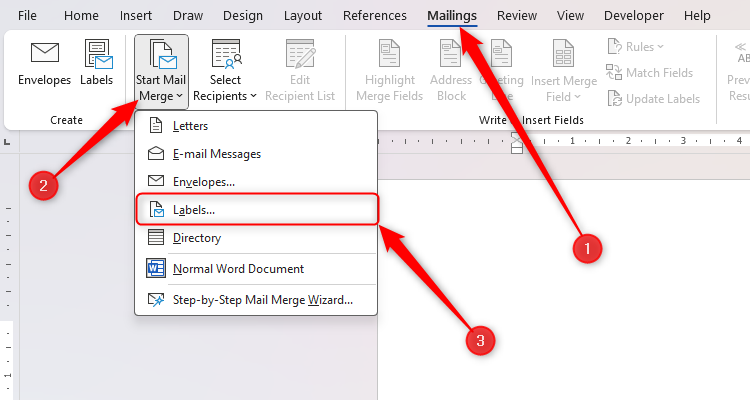
To save paper, scroll down to and select "30 Per Page," and click "OK."
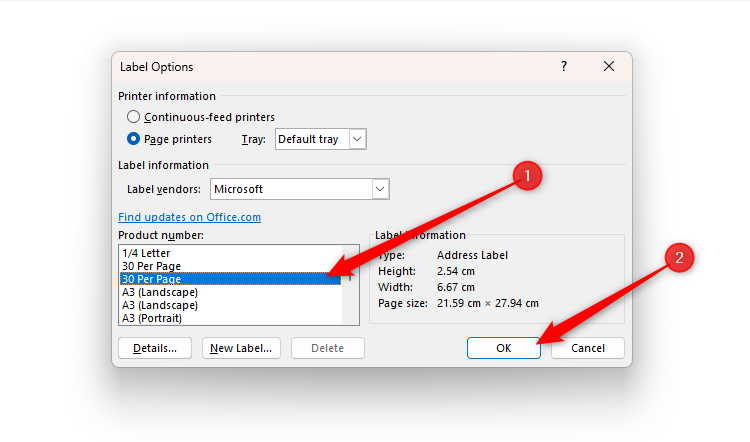
Turning on the Show/Hide (¶) option in the Home tab will help you see the layout and positioning of the labels you have just created.
The next step is to import the address list that you created in Excel. To do this, with the Mailings tab still open, click Select Recipients > Use An Existing List.
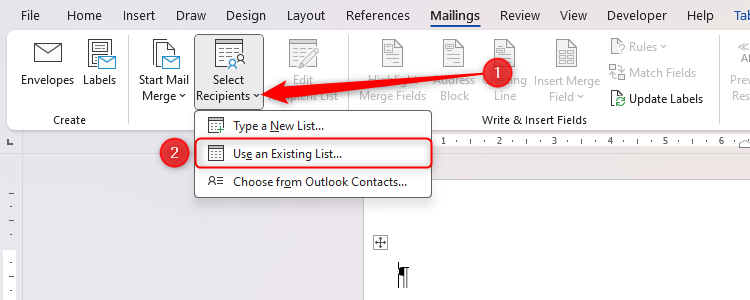
Use the Select Data Source window that opens to locate the Excel file containing the names and addresses, and click "Open." In the Select Table dialog box, check the checkbox that tells Word that you've used headings in your Excel table, and then click "OK".
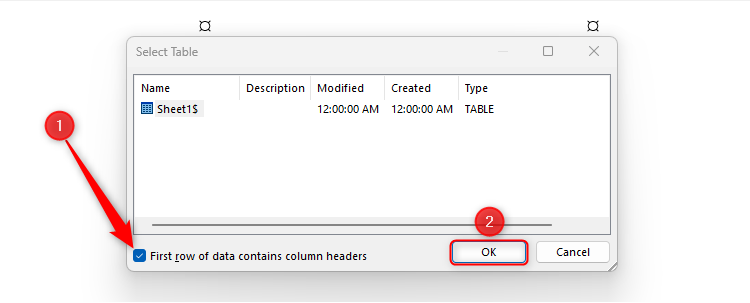
Word is now ready to pull the data across from Excel.
Click "Insert Merge Field," and see that the headings you created in Excel are listed in the drop-down. Start by clicking the item you want to appear on the first line of the address label ("Name"), and then press Enter. Repeat the process for each line of the address label, making sure you press Enter between each one.
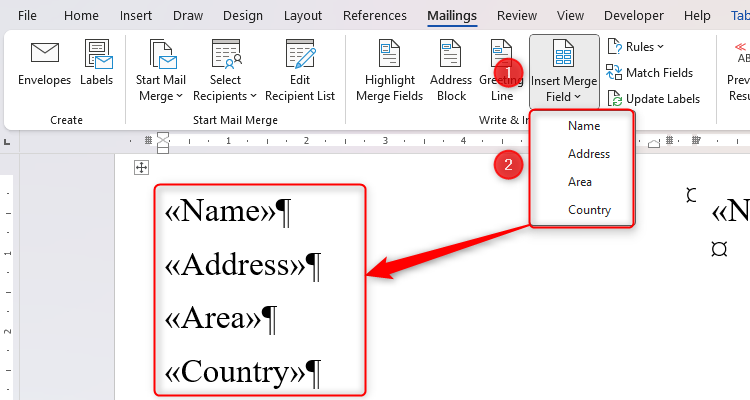
If the text runs over the space provided for the labels, increase the label sizes by clicking and dragging the bottom of the label row downwards, then remove any labels that move to the next page .
When you have inserted all merge fields, click "Update Labels." This will apply the merge fields you just added to each of the labels in your document.
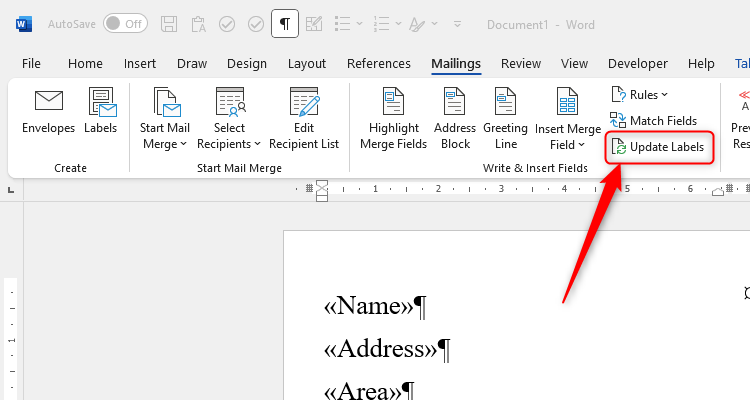
Now, click "Preview Results" to check you're happy with how your labels look.
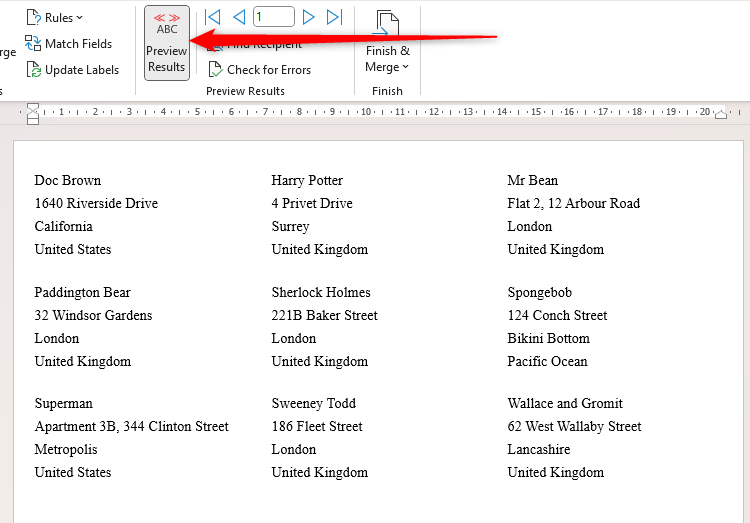
To complete the process, click Finish And Merge > Print Documents.
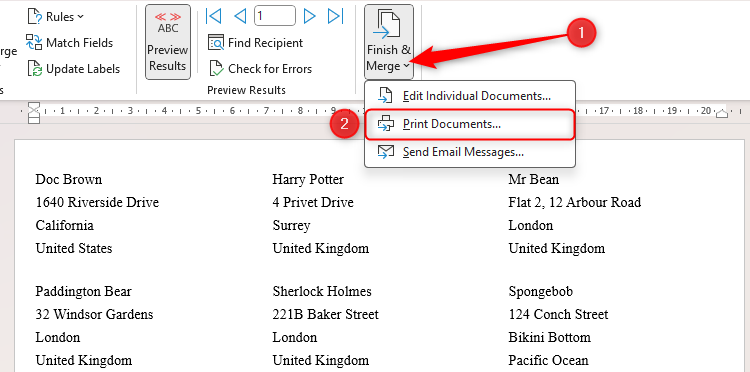
If you want to make changes to individual addresses, click Finish And Merge > Edit Individual Documents. This will open the labels in a new document, where you can make changes without affecting the other entries.
Then, ensure "All" is selected, and click "OK" to print.
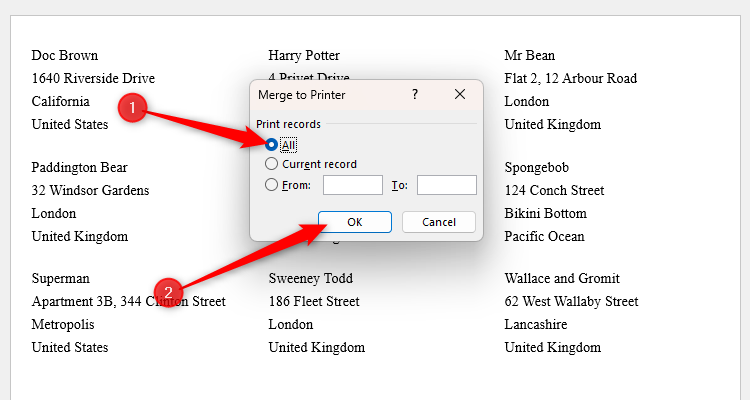
Finally, cut up your labels and stick them onto your envelopes!
While the example we're going to use will be for teachers writing school reports, the same process can be used in many different roles and professions, such as surveying, assessing, managing, and reviewing.
In a Word document, type the foundation of the report, using "[NAME]" where a person's name will go, and "__" wherever an individualized part needs to be added.
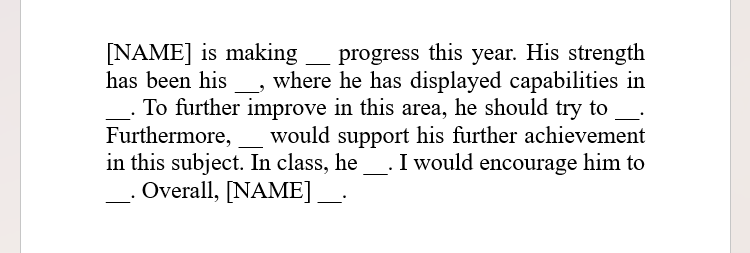
Then, copy each sentence into a cell across row 1 of an Excel sheet, making sure you add a "Name" column at the start.

Then, fill in the gaps under each column for each report you want to generate, before pressing F12 to name and save the spreadsheet in a memorable location.
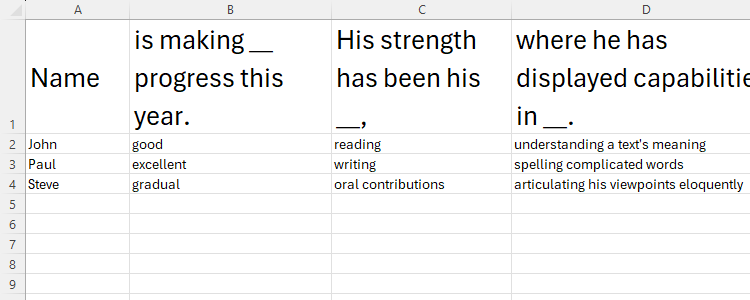
Now, return to your Word document. In the Mailings tab, click Select Recipients > Use An Existing List.
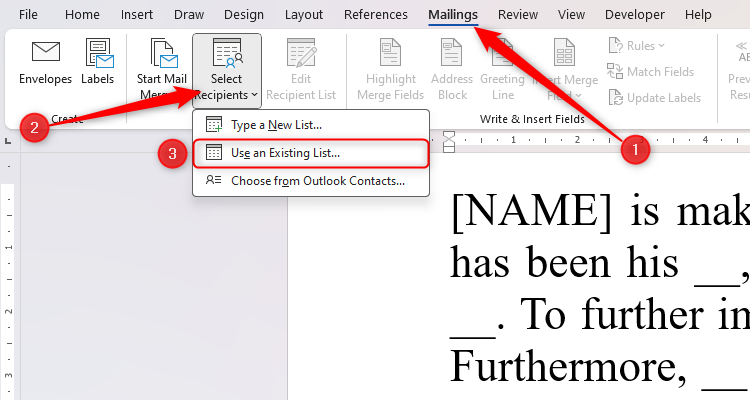
In the Select Data Source window that opens, locate the Excel sheet containing the report details, and click "Open." Then, in the Select Table dialog box, check the checkbox that tells Word that you've used headings in your Excel table, and click "OK".
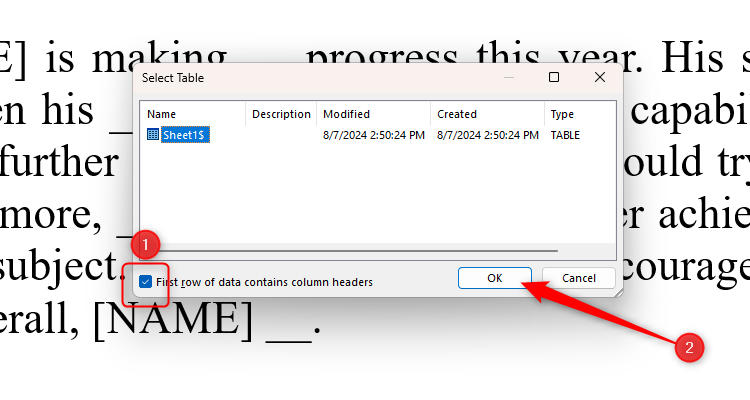
Now, select the areas where you used [NAME] or inserted blanks in your Word document, click "Insert Merge Field," and choose the appropriate field via the "Insert Merge Field" drop-down to add it to the sentence.
![cover letter for job application in university A report in Word, with [NAME] selected, and the relevant field from the Insert Merge Field drop-down selected.](https://static1.howtogeekimages.com/wordpress/wp-content/uploads/2024/08/a-report-in-word-with-name-selected-and-the-relevant-field-from-the-insert-merge-field-drop-down-selected.png)
After you have assigned all the fields from Excel, click "Preview Results" to see the first report. You can also use the arrows to flick through all the reports if you wish.
Finally, click "Finish and Merge," which gives you the option to review and amend the documents individually, or print the reports you generated.
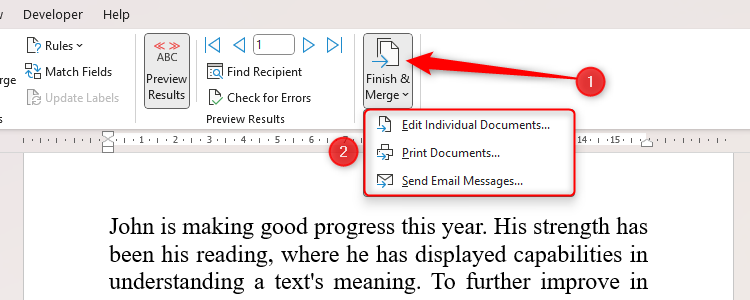
It can be frustrating to regurgitate the same information in various cover letters for the many jobs you might apply for. After all, the skills you have can be applied to many different roles. This is where mail merge comes into play.
Across row 1 in a blank Excel worksheet, type the different skill categories you fall into.

In row 2, underneath each skill, write a few sentences demonstrating your possession of that skill. These sentences will ultimately be exported into your cover letter, so make sure you write them with this in mind.
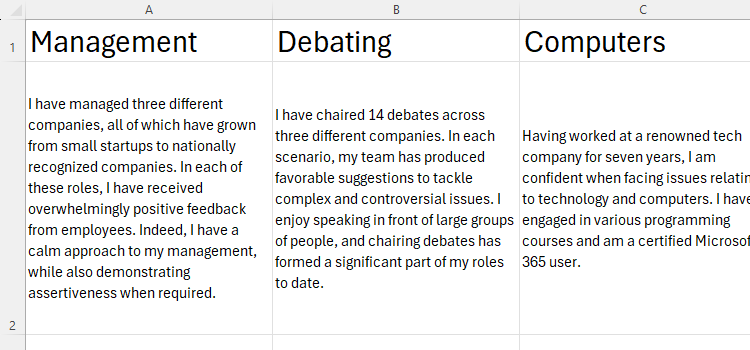
Once you have finished detailing your skills, press F12 to name and save the workbook. You can go back in and add to or amend the details in this sheet at any time.
Next, when you've found a job you want to apply for , open a new Microsoft Word document, and type the opening and ending of your cover letter. Then, in the Mailings tab, click Select Recipients > Use An Existing List.
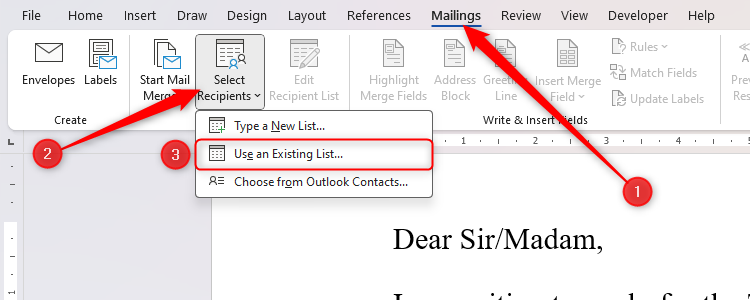
In the Select Data Source window that opens, locate the Excel sheet containing your skills, and click "Open." Then, in the Select Table dialog box, check the checkbox that tells Word that you've used headings in your Excel table, and click "OK".
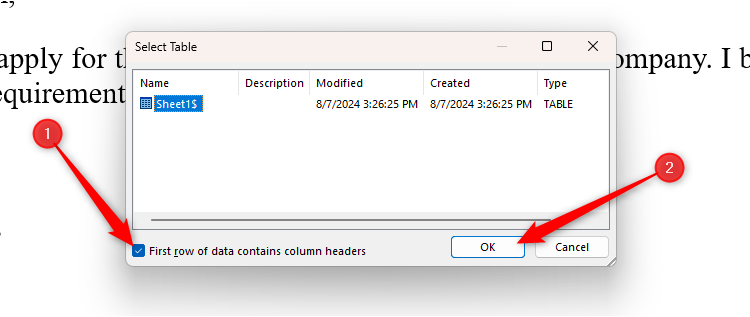
Then, click "Insert Merge Field," and choose the job skill that you detailed in your Excel spreadsheet.
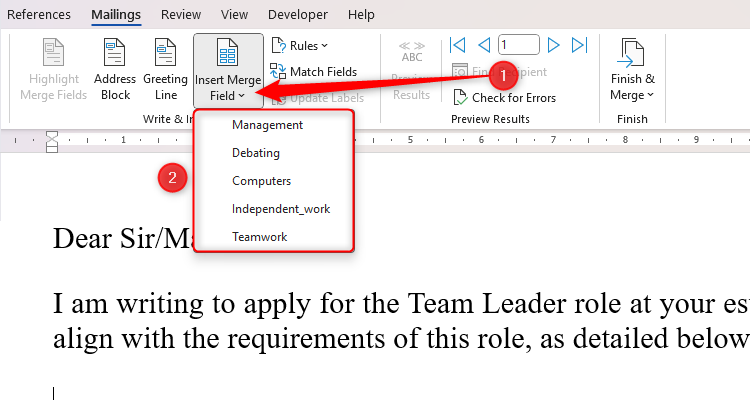
You will then see a placeholder indicating that the text will appear in that position when you complete the mail merge.
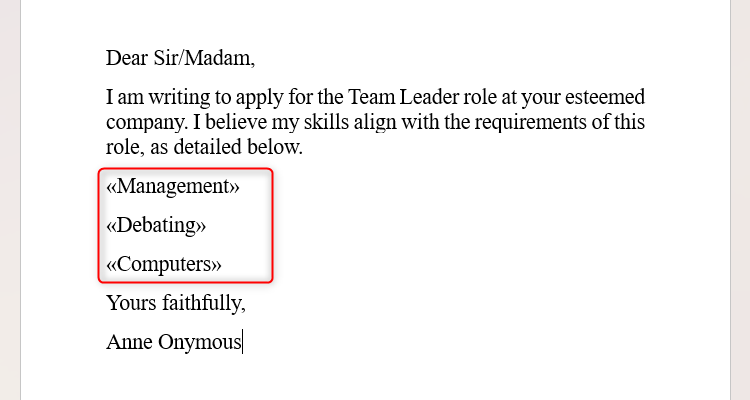
When you have added all your skills, click "Preview Results" to check that you are happy with the structure and order of your paragraphs. If not, you can select and reorder your text.
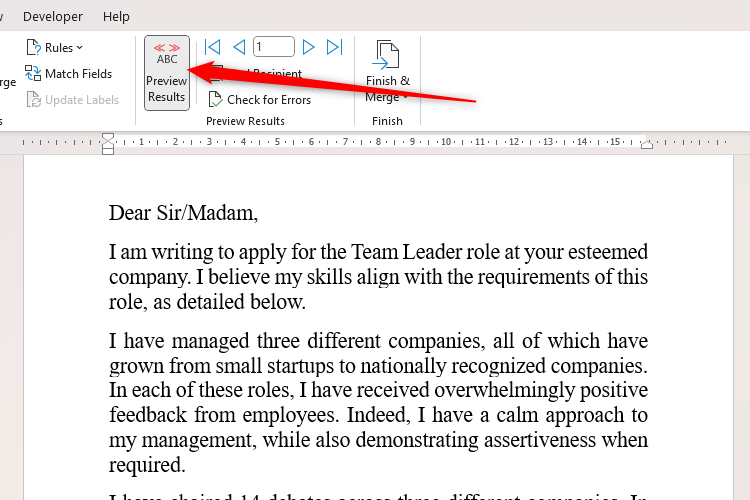
Inevitably, you will want to amend the wording here and there to ensure that the letter is coherent. Using the mail merge technique described in this article forms the basis of your cover letter, but you should always check it through to ensure it runs smoothly. To make changes, click "Finish And Merge," and select "Edit Individual Documents." After you click "OK," your completed cover letter will open in a new document, which you can then amend and save as necessary.
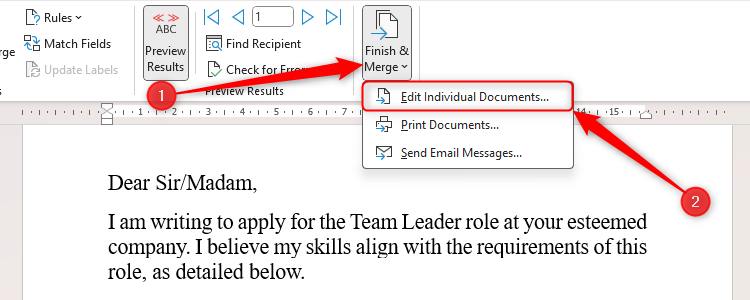
Whether you run a local football team or a kids' activity center, you might want to create certificates for your participants.
First, create your list in Excel, including things like the recipients' names, scores, standards, and whatever other individualized details you want to include. Then, press F12 to name and save these details.
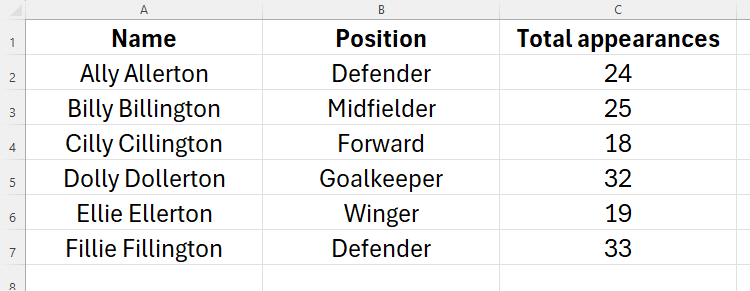
Next, design your certificate in Microsoft Word. If you prefer, you can use a template by clicking File > Home > More Templates.
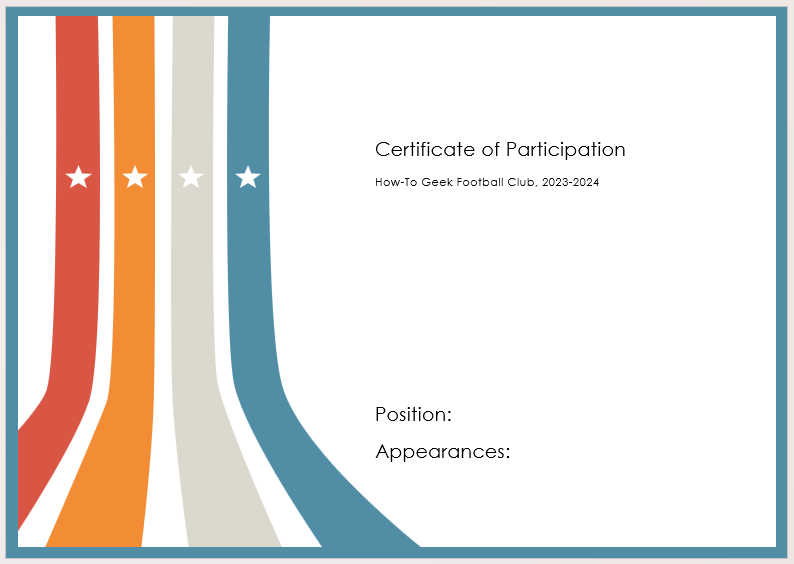
Now, in the Mailings tab, click Select Recipients > Use An Existing List.
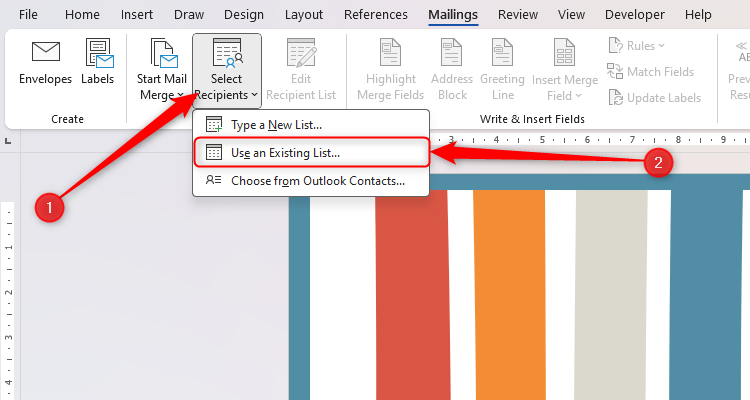
Locate the recipients' details that you created in Excel, click "Open", check "First Row Of Data Contains Column Headers," and click "OK."
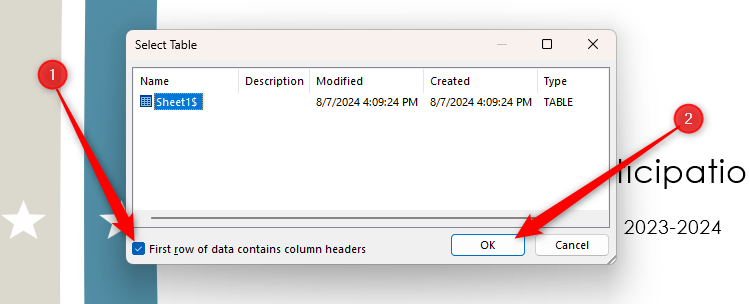
Then, click "Insert Merge Field" to add the fields from your Excel sheet to your Word document where appropriate.
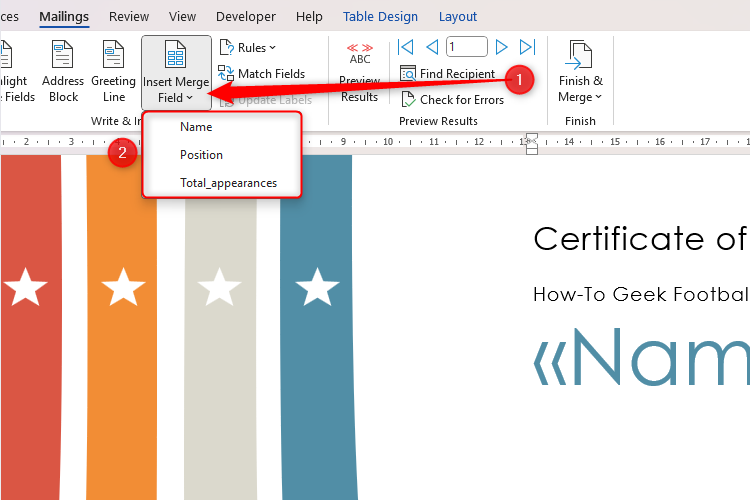
Before you finalize your certificates, click "Preview Results" to check that everything looks as it should, and then click Finish And Merge > Print Documents.
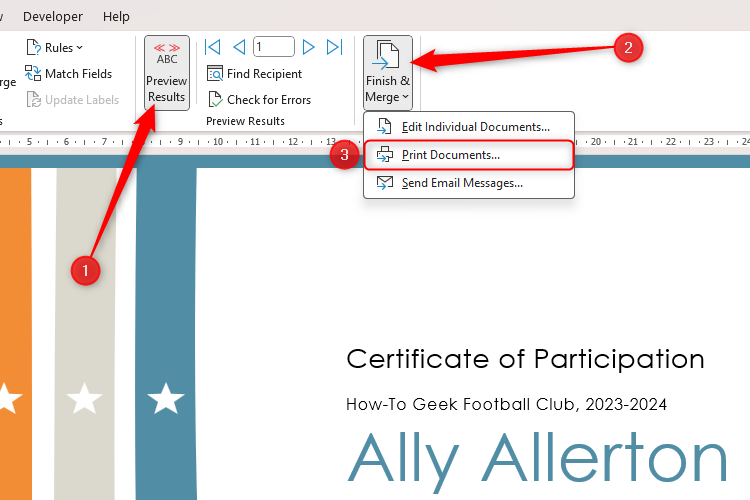
Now that you have some ideas for using mail merge for everyday tasks, check out some of our other little-known Microsoft Word tips .
- Microsoft Word
- Microsoft Excel

IMAGES
COMMENTS
Here are 6 examples of skills to describe in a university student cover letter. Communication (always describe your style of communication) Collaboration and teamwork. Leadership. Critical thinking. Time management. Responsibility. Here is an example of how to describe an accomplishment in a cover letter.
A 1-3 page cover letter might be the norm when applying for a tenure-track faculty position, but you need to check with your own department to find out what the standards are in your field. Step 3: Go through the job ad and carefully note all of the requirements and skills the employer is looking for. Based on your background research of the ...
A cover letter is more than a resume in paragraph form. 3 The format, content and purpose of a cover letter are highly individualized. • Follow basic professional writing standards, paying special attention to differences in uploading a cover letter into an online application or using your letter as the body of an email message.
At their most basic level, academic cover letters accomplish three things: one, they express your interest in the job; two, they provide a brief synopsis of your research and teaching; and three, they summarize your past experiences and achievements to illustrate your competence for the job. For early-career scholars, cover letters are ...
Academic cover letter sample Use this sample to help craft your own academic cover letter: Malik Hanson Providence, Rhode Island 312-209-9389 [email protected] Feb. 1, 2023 Hiring committee Teal University Department of English 12 Teal Ave. Providence, Rhode Island 02902 Dear Hiring committee, I am writing to apply for the Tenure-Track English Professor position at Teal University as ...
Use a proper salutation. Begin your college application letter with a formal salutation. The standard, in this case, is "Dear". Be sure to avoid informal salutations such as "Hey", "Hi", and "Hello". 💡 Tip: Do your best to personalize your university application letter in every way that you can.
Follow these steps to write an impressive college application cover letter: 1. Write your name and street address. At the top of your cover letter, write your first and last name. On a separate line include your street address, followed by your city, state and zip code on another line. 2.
Your cover letter will be read by someone as part of a formal job application, so make certain that it is free of spelling mistakes, grammar issues, and typos. Make sure your cover letter fits onto 1 page (for non-academic position applications), has consistent margins and formatting, and a readable font that is between 10-12pts.
The First Paragraph. In the opening of your letter you need to convey some basic information, such as what specific position you are applying for (using the title given in the job notice) and where you learned of the opening. Since a cover letter is a kind of persuasive writing (persuading a hiring committee to include you on a list of ...
cover letter is as effective as possible. The power of the cover letter in making an effective job application should never be underestimated. A good cover letter will grab the employer's attention and make them want to read your CV. The purpose of your cover letter and CV together is to whet the employer's appetite, to establish you
With an academic cover letter template like that, they'd have to interview you. 1. Use a Respected Academic Cover Letter Template. Writing a good cover letter for university jobs takes certain core requirements. This academic cover letter template has them. Hit all the right notes and the department chair is bound to notice you.
Academic Cover Letter Sample. November 2, 1998. Dear Dr. Sellers: I am writing to apply for the position as assistant professor of English with an emphasis in rhetoric and composition that you advertised in the October MLA Job Information List. I am a graduate student at Prestigious University working on a dissertation under the direction of ...
A successful cover letter for a university application should contain specific elements that demonstrate the applicant's qualifications, achievements, and passion for the program. These elements include: Addressing the letter to the appropriate recipient. Crafting an engaging introduction that captures the reader's attention.
STEM letters should not exceed one page. Humanities and social sciences letters may extend up to two pages. Check with faculty in your department. Address to the individual named in the job posting, or with "Dear Members of the Search Committee." The cover letter is a writing sample. It must be good. Proofread and spell check! TIPS
Undergraduate Internship. New York, NY | [email protected] | (212) 555-0000. I am writing to express my interest in CNN's editorial internship as part of the Columbia Experience Overseas Hong Kong. With a keen interest in media production and journalism, I am eager to explore these fields in one of the world's fastest-growing markets.
Download our sample cover letter to see a properly formatted, well-written example of a successful cover letter. To see additional cover letter samples, visit Resume Worded and sign in with your Georgetown email address. Cawley Career Education Center. 1 Leavey Center. 37th and O Streets, N.W.
Sections of a university cover letter. The format of a university cover letter is defined by its key sections, its structure, and its text volume. In most cases, a university cover letter should be one page only, with a maximum of 300 words. Unlike a 100,000-word doctoral dissertation, a cover letter prizes brevity and economy of words.
Writing an impressive cover letter is a crucial step in landing a job working at a University, so taking the time to perfect it is well worth while. By following the tips and examples above you will be able to create an eye-catching cover letter that will wow recruiters and ensure your CV gets read - leading to more job interviews for you.
Steps for Writing a Cover Letter. Key points in writing a Cover Letter (Can be the body of an email): Typically, three paragraphs. Paragraph 1. Introduce yourself, briefly identify your academic and employment background, refer to the position, and explain how you heard about the position. Can also be a letter of interest for future ...
Cover letters for job applications. [date] Dear [insert Ms/Mr Xxx or Sir/Madam] Application for position of [name of role], Reference Number [if given] OPENING PARAGRAPH (S): The purpose of this letter, and why them. Paragraph 1: start by referring to the position you're applying for (or "I am applying for the above position" if formatted ...
Academic Cover Letter Example #2 (Text Version) Betty Applicant 567 North Street, Boston, MA 02108 555-555.555 [email protected]. April 5, 2021. Dr. Robert Smith Chair, Department of Biology Acme University 123 Business Rd. Business City, NY 54321. Dear Dr. Smith, I am writing to apply for the position of Assistant Professor of Biology ...
Tell your story. Your cover letter gives life to your résumé by introducing you, your achievements and your potential to a prospective employer. Review our cover letter guide and cover letter example to help guide you in crafting your own story.
Introduction. These resources will help you understand and write successful cover letters. To use these pages, you may select links in the navigation bar on the left, you may select links from the list below, or you may advance through the pages using the links at the bottom of each page. Click here to download the PDF file containing sample ...
Share This: Share Cover Letter Checklist + Outline (2024) on Facebook Share Cover Letter Checklist + Outline (2024) on LinkedIn ... Resume and Employment Guide for People With Disabilities; ... Contact & Location. Phone (210) 458-4589. Email. [email protected]. Address. UTSA University Career Center One UTSA Circle San Antonio, TX 78249.
Scholarship applications: When applying for scholarships, this kind of letter can help you stand out by showcasing your academic achievements and career goals. Volunteer positions: Some volunteer organizations require an application letter to understand your motivations and skills relevant to the position. Internship applications: Internships often require this document to understand your ...
Writing Job Application Cover Letters It can be frustrating to regurgitate the same information in various cover letters for the many jobs you might apply for. After all, the skills you have can be applied to many different roles. This is where mail merge comes into play. Across row 1 in a blank Excel worksheet, type the different skill ...